Preparation of Accounting Records using Spreadsheets
VerifiedAdded on 2023/04/21
|34
|5313
|258
AI Summary
This document provides information on the preparation of accounting records using spreadsheets. It covers topics such as journal entries, T-accounts, unadjusted trial balance, and adjusting entries. The document also includes examples and formulas for each topic. If you need further assistance or study material on this topic, you can find it at Desklib.
Contribute Materials
Your contribution can guide someone’s learning journey. Share your
documents today.
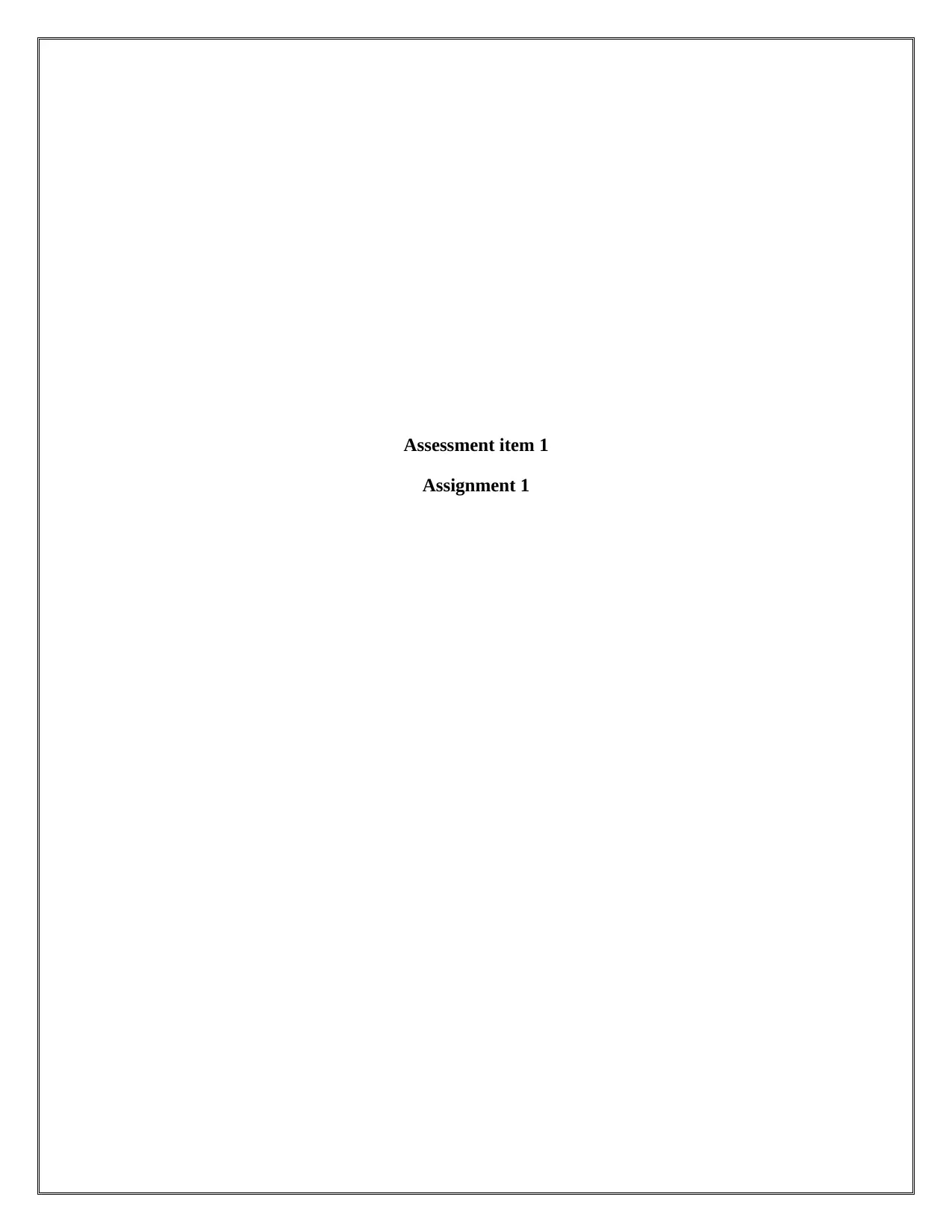
Assessment item 1
Assignment 1
Assignment 1
Secure Best Marks with AI Grader
Need help grading? Try our AI Grader for instant feedback on your assignments.
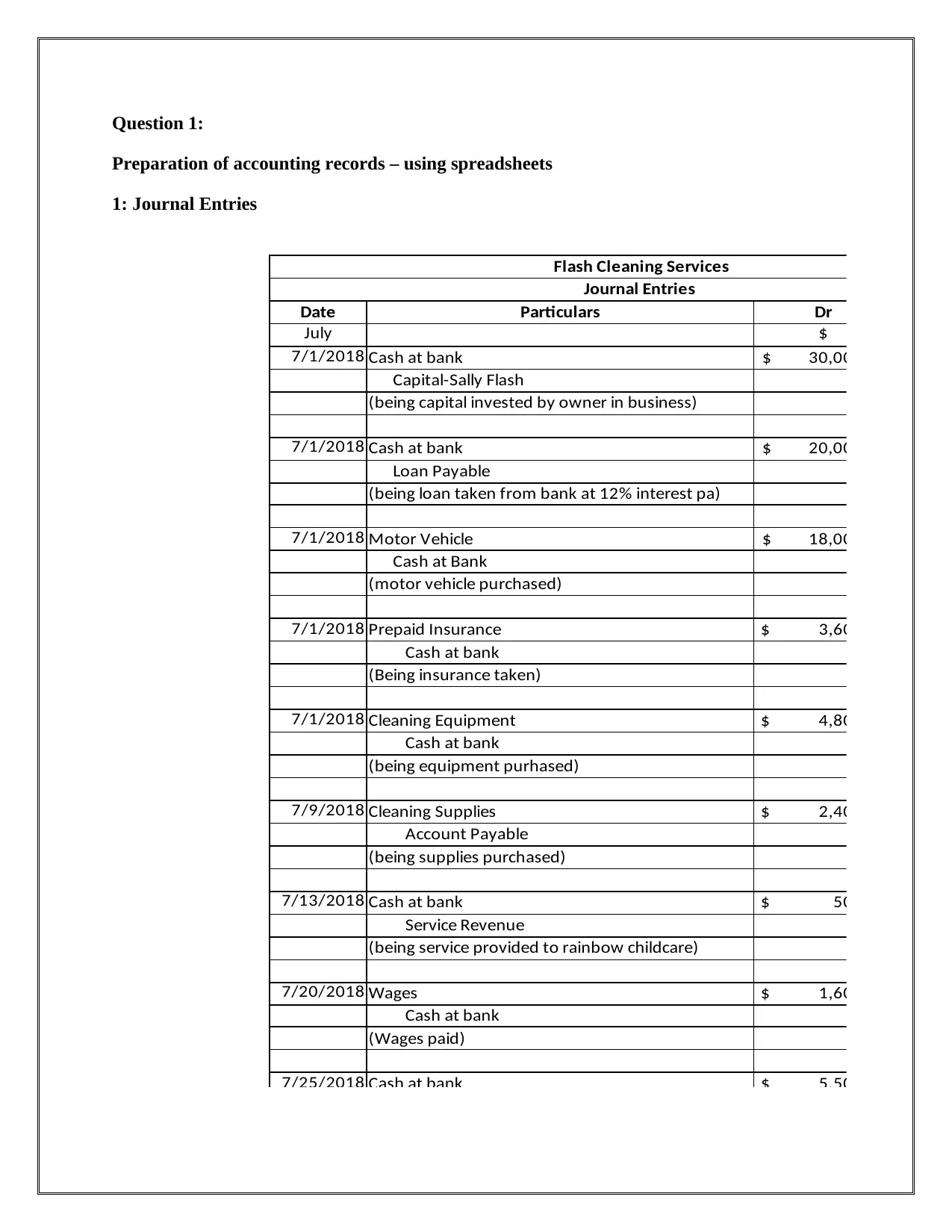
Question 1:
Preparation of accounting records – using spreadsheets
1: Journal Entries
Flash Cleaning Services
Journal Entries
Date Particulars Dr
July $
7/1/2018 Cash at bank $ 30,000.00
Capital-Sally Flash
(being capital invested by owner in business)
7/1/2018 Cash at bank $ 20,000.00
Loan Payable
(being loan taken from bank at 12% interest pa)
7/1/2018 Motor Vehicle $ 18,000.00
Cash at Bank
(motor vehicle purchased)
7/1/2018 Prepaid Insurance $ 3,600.00
Cash at bank
(Being insurance taken)
7/1/2018 Cleaning Equipment $ 4,800.00
Cash at bank
(being equipment purhased)
7/9/2018 Cleaning Supplies $ 2,400.00
Account Payable
(being supplies purchased)
7/13/2018 Cash at bank $ 500.00
Service Revenue
(being service provided to rainbow childcare)
7/20/2018 Wages $ 1,600.00
Cash at bank
(Wages paid)
7/25/2018 Cash at bank $ 5,500.00
Preparation of accounting records – using spreadsheets
1: Journal Entries
Flash Cleaning Services
Journal Entries
Date Particulars Dr
July $
7/1/2018 Cash at bank $ 30,000.00
Capital-Sally Flash
(being capital invested by owner in business)
7/1/2018 Cash at bank $ 20,000.00
Loan Payable
(being loan taken from bank at 12% interest pa)
7/1/2018 Motor Vehicle $ 18,000.00
Cash at Bank
(motor vehicle purchased)
7/1/2018 Prepaid Insurance $ 3,600.00
Cash at bank
(Being insurance taken)
7/1/2018 Cleaning Equipment $ 4,800.00
Cash at bank
(being equipment purhased)
7/9/2018 Cleaning Supplies $ 2,400.00
Account Payable
(being supplies purchased)
7/13/2018 Cash at bank $ 500.00
Service Revenue
(being service provided to rainbow childcare)
7/20/2018 Wages $ 1,600.00
Cash at bank
(Wages paid)
7/25/2018 Cash at bank $ 5,500.00
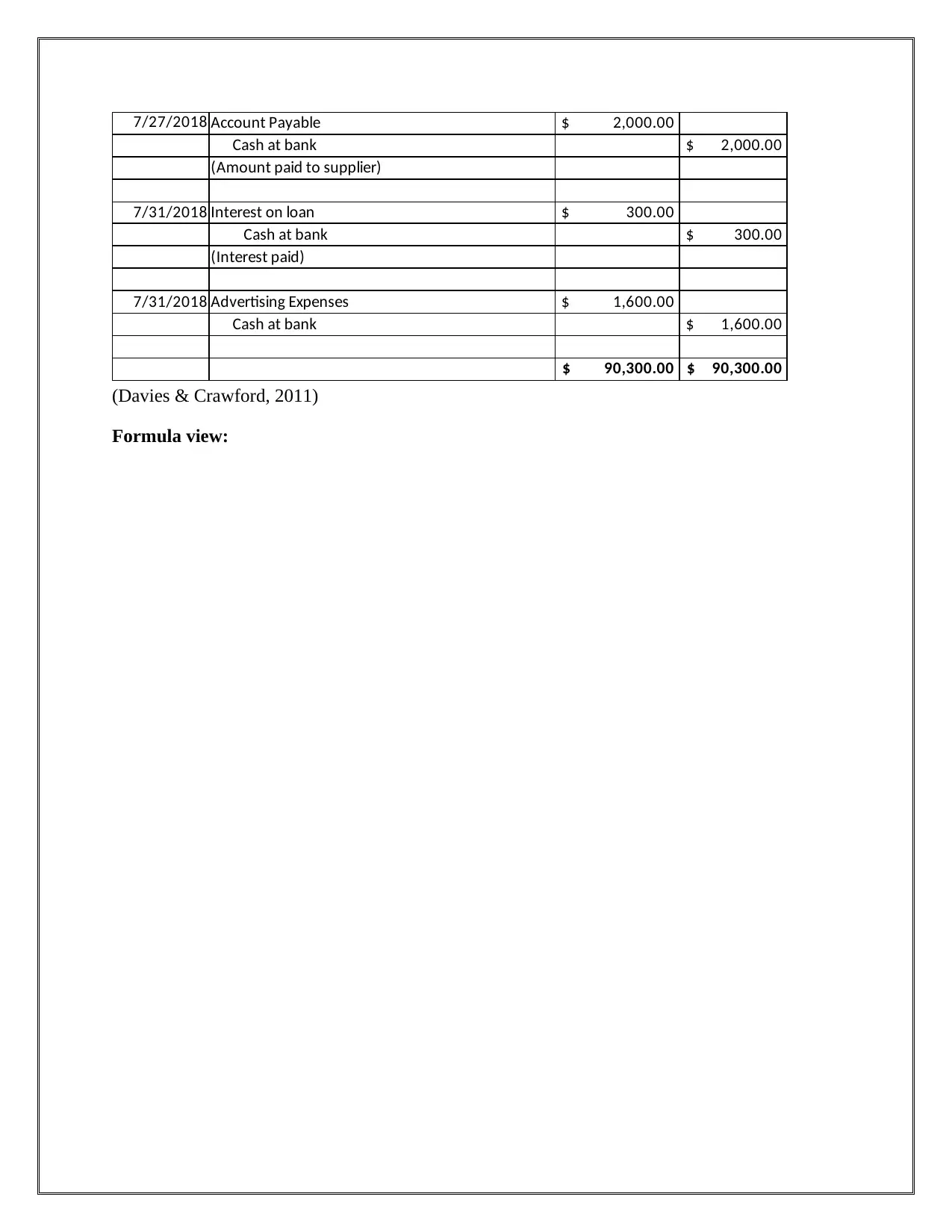
7/27/2018 Account Payable $ 2,000.00
Cash at bank $ 2,000.00
(Amount paid to supplier)
7/31/2018 Interest on loan $ 300.00
Cash at bank $ 300.00
(Interest paid)
7/31/2018 Advertising Expenses $ 1,600.00
Cash at bank $ 1,600.00
$ 90,300.00 $ 90,300.00
(Davies & Crawford, 2011)
Formula view:
Cash at bank $ 2,000.00
(Amount paid to supplier)
7/31/2018 Interest on loan $ 300.00
Cash at bank $ 300.00
(Interest paid)
7/31/2018 Advertising Expenses $ 1,600.00
Cash at bank $ 1,600.00
$ 90,300.00 $ 90,300.00
(Davies & Crawford, 2011)
Formula view:

### Cash at bank ###
Service Revenue
(being service provided to rainbow childcare)
Service Revenue
(being service provided to rainbow childcare)
Secure Best Marks with AI Grader
Need help grading? Try our AI Grader for instant feedback on your assignments.
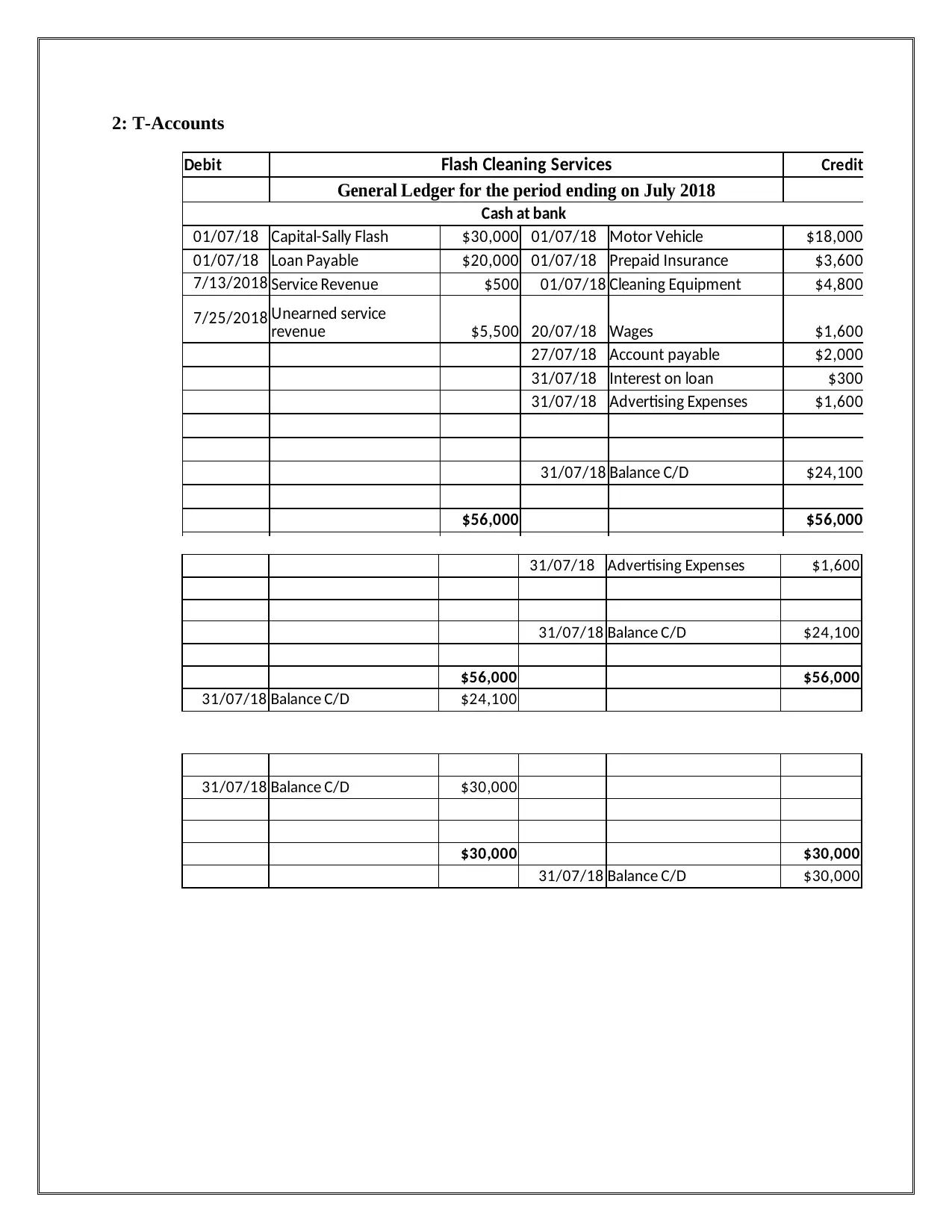
2: T-Accounts
Debit Flash Cleaning Services Credit
General Ledger for the period ending on July 2018
Cash at bank
01/07/18 Capital-Sally Flash $30,000 01/07/18 Motor Vehicle $18,000
01/07/18 Loan Payable $20,000 01/07/18 Prepaid Insurance $3,600
7/13/2018 Service Revenue $500 01/07/18 Cleaning Equipment $4,800
7/25/2018 $5,500 20/07/18 Wages $1,600
27/07/18 Account payable $2,000
31/07/18 Interest on loan $300
31/07/18 Advertising Expenses $1,600
31/07/18 Balance C/D $24,100
$56,000 $56,000
Unearned service
revenue
31/07/18 Advertising Expenses $1,600
31/07/18 Balance C/D $24,100
$56,000 $56,000
31/07/18 Balance C/D $24,100
31/07/18 Balance C/D $30,000
$30,000 $30,000
31/07/18 Balance C/D $30,000
Debit Flash Cleaning Services Credit
General Ledger for the period ending on July 2018
Cash at bank
01/07/18 Capital-Sally Flash $30,000 01/07/18 Motor Vehicle $18,000
01/07/18 Loan Payable $20,000 01/07/18 Prepaid Insurance $3,600
7/13/2018 Service Revenue $500 01/07/18 Cleaning Equipment $4,800
7/25/2018 $5,500 20/07/18 Wages $1,600
27/07/18 Account payable $2,000
31/07/18 Interest on loan $300
31/07/18 Advertising Expenses $1,600
31/07/18 Balance C/D $24,100
$56,000 $56,000
Unearned service
revenue
31/07/18 Advertising Expenses $1,600
31/07/18 Balance C/D $24,100
$56,000 $56,000
31/07/18 Balance C/D $24,100
31/07/18 Balance C/D $30,000
$30,000 $30,000
31/07/18 Balance C/D $30,000
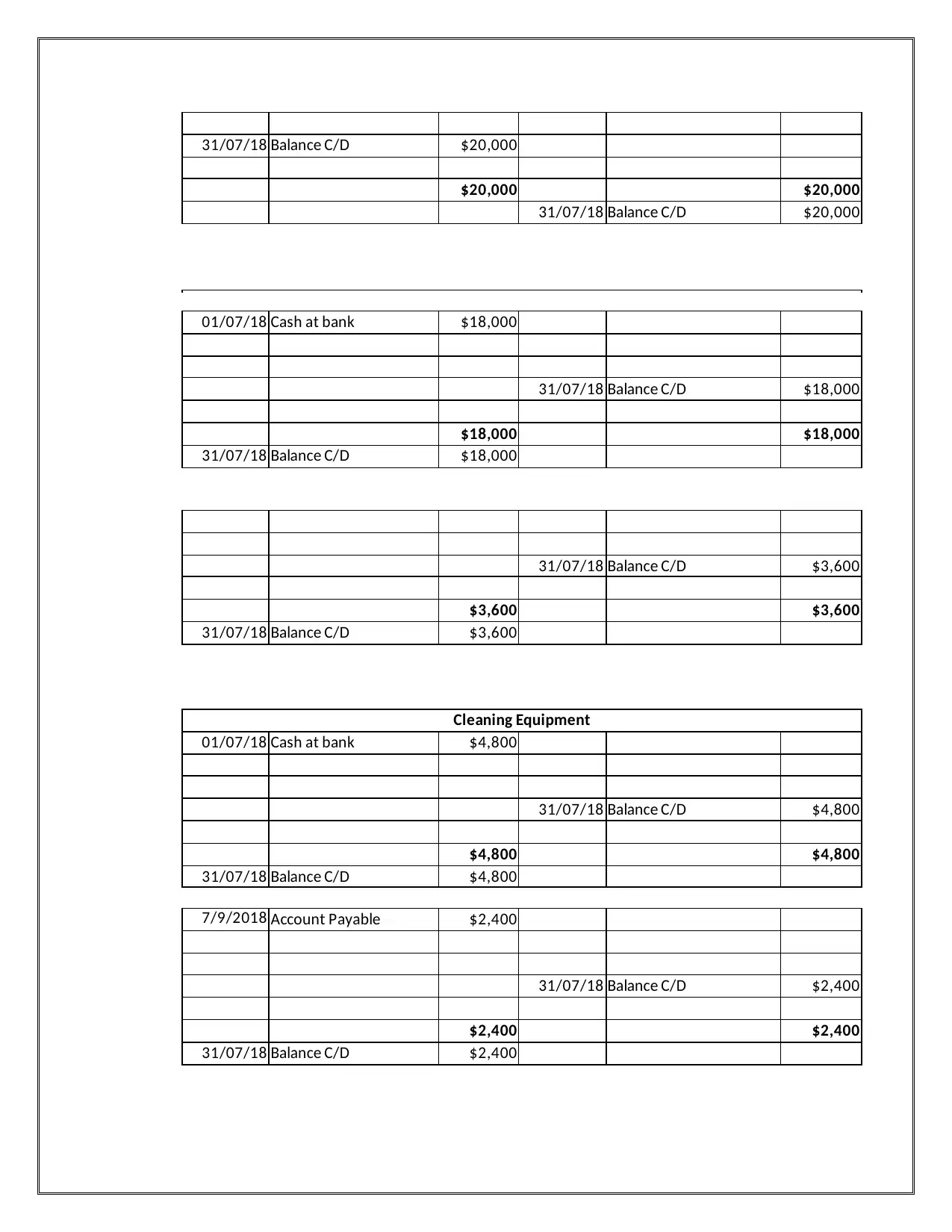
31/07/18 Balance C/D $20,000
$20,000 $20,000
31/07/18 Balance C/D $20,000
01/07/18 Cash at bank $18,000
31/07/18 Balance C/D $18,000
$18,000 $18,000
31/07/18 Balance C/D $18,000
31/07/18 Balance C/D $3,600
$3,600 $3,600
31/07/18 Balance C/D $3,600
Cleaning Equipment
01/07/18 Cash at bank $4,800
31/07/18 Balance C/D $4,800
$4,800 $4,800
31/07/18 Balance C/D $4,800
7/9/2018 Account Payable $2,400
31/07/18 Balance C/D $2,400
$2,400 $2,400
31/07/18 Balance C/D $2,400
$20,000 $20,000
31/07/18 Balance C/D $20,000
01/07/18 Cash at bank $18,000
31/07/18 Balance C/D $18,000
$18,000 $18,000
31/07/18 Balance C/D $18,000
31/07/18 Balance C/D $3,600
$3,600 $3,600
31/07/18 Balance C/D $3,600
Cleaning Equipment
01/07/18 Cash at bank $4,800
31/07/18 Balance C/D $4,800
$4,800 $4,800
31/07/18 Balance C/D $4,800
7/9/2018 Account Payable $2,400
31/07/18 Balance C/D $2,400
$2,400 $2,400
31/07/18 Balance C/D $2,400
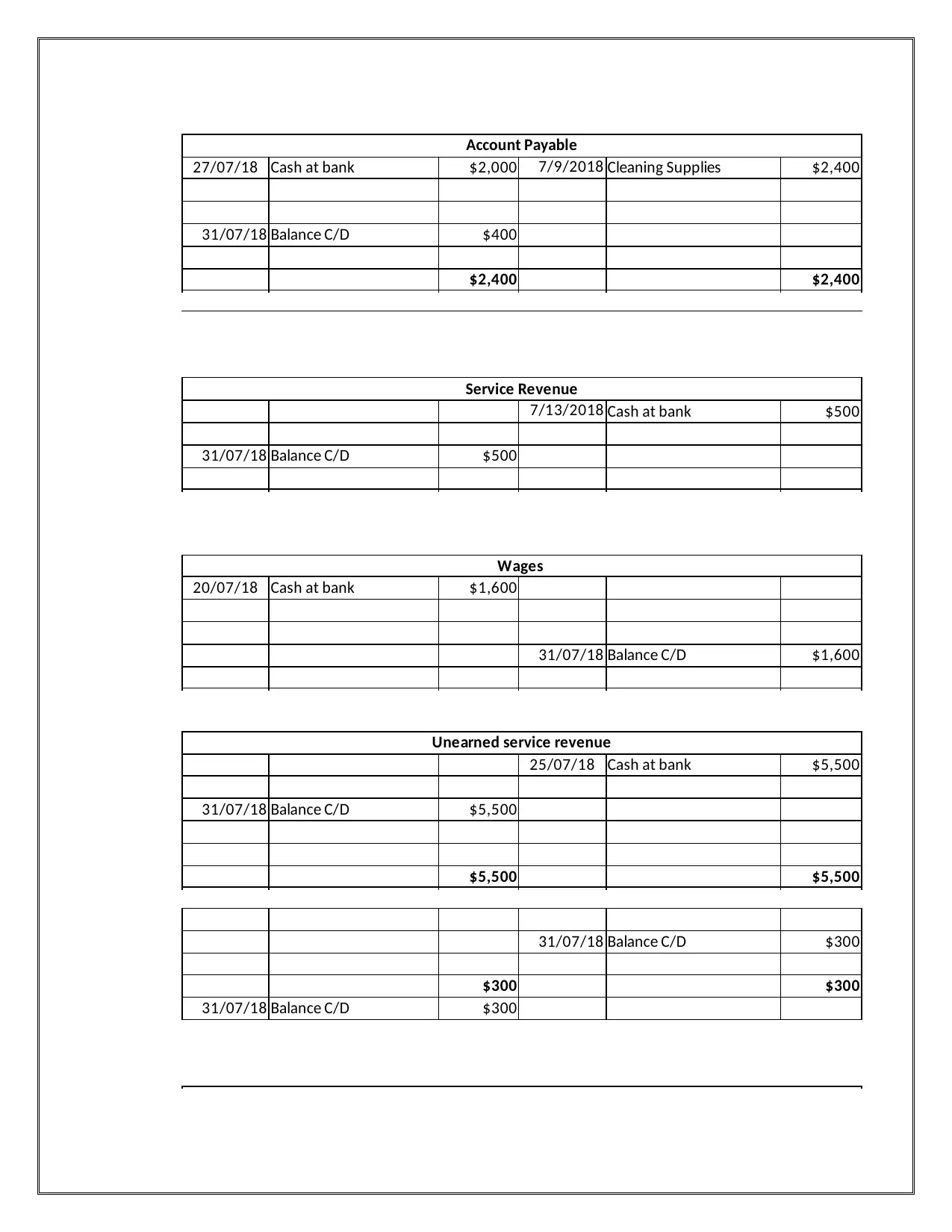
Account Payable
27/07/18 Cash at bank $2,000 7/9/2018 Cleaning Supplies $2,400
31/07/18 Balance C/D $400
$2,400 $2,400
Service Revenue
7/13/2018 Cash at bank $500
31/07/18 Balance C/D $500
Wages
20/07/18 Cash at bank $1,600
31/07/18 Balance C/D $1,600
Unearned service revenue
25/07/18 Cash at bank $5,500
31/07/18 Balance C/D $5,500
$5,500 $5,500
31/07/18 Balance C/D $300
$300 $300
31/07/18 Balance C/D $300
27/07/18 Cash at bank $2,000 7/9/2018 Cleaning Supplies $2,400
31/07/18 Balance C/D $400
$2,400 $2,400
Service Revenue
7/13/2018 Cash at bank $500
31/07/18 Balance C/D $500
Wages
20/07/18 Cash at bank $1,600
31/07/18 Balance C/D $1,600
Unearned service revenue
25/07/18 Cash at bank $5,500
31/07/18 Balance C/D $5,500
$5,500 $5,500
31/07/18 Balance C/D $300
$300 $300
31/07/18 Balance C/D $300
Paraphrase This Document
Need a fresh take? Get an instant paraphrase of this document with our AI Paraphraser
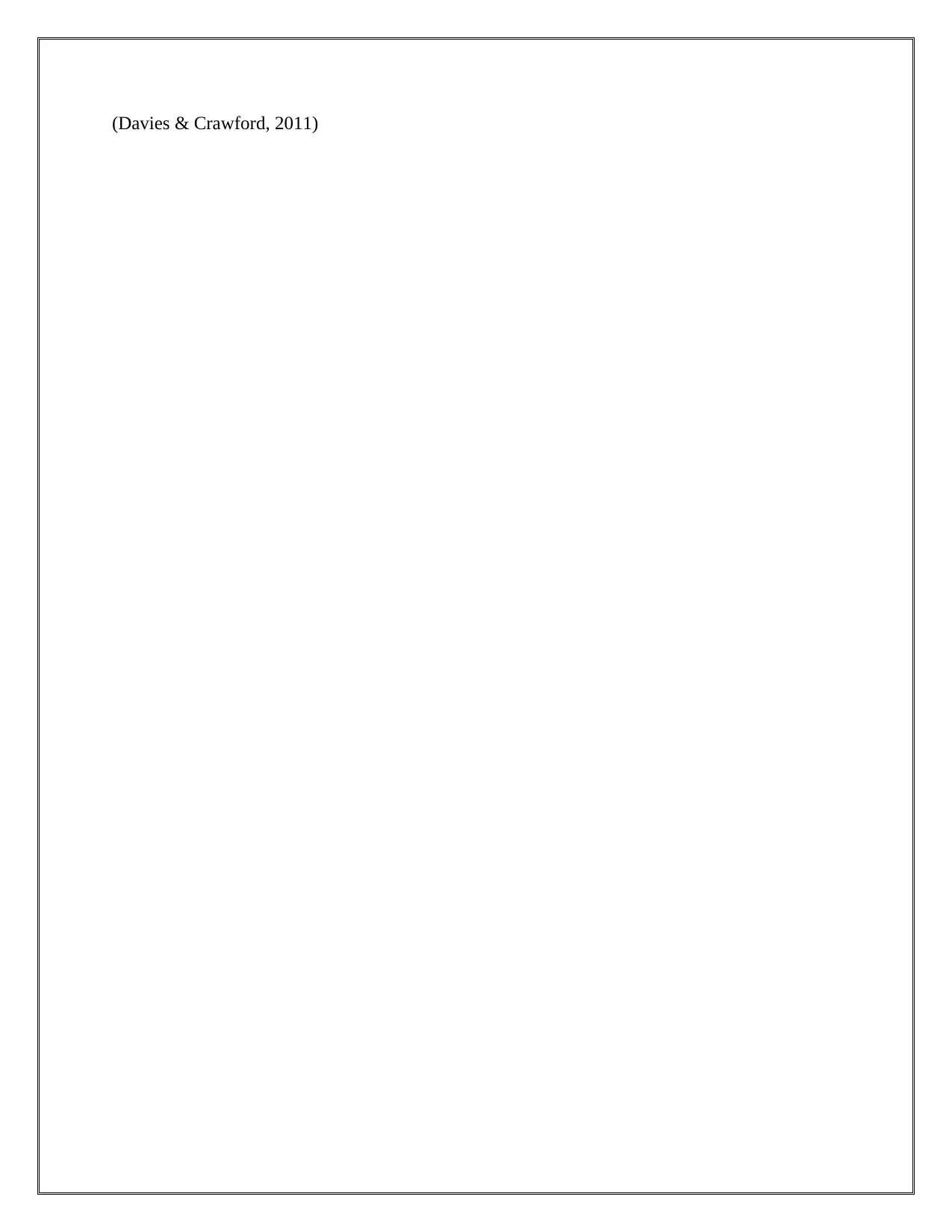
(Davies & Crawford, 2011)
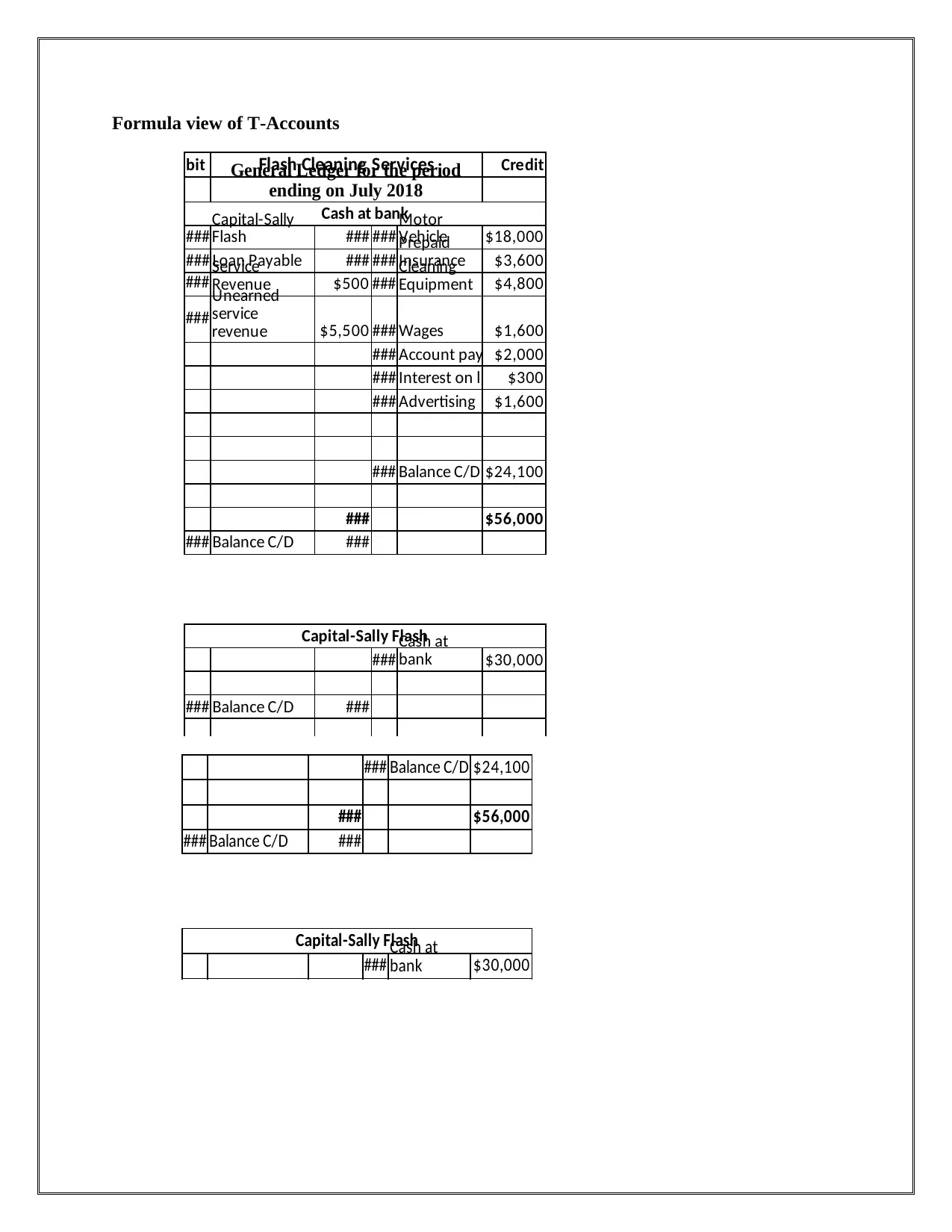
Formula view of T-Accounts
Flash Cleaning Services Credit
Cash at bank
### ### ### $18,000
### Loan Payable ### ### $3,600
### $500 ### $4,800
### $5,500 ### Wages $1,600
### Account pay $2,000
### Interest on l $300
### Advertising $1,600
### Balance C/D $24,100
### $56,000
### Balance C/D ###
Capital-Sally Flash
### $30,000
### Balance C/D ###
De
bit General Ledger for the period
ending on July 2018
Capital-Sally
Flash
Motor
VehiclePrepaid
InsuranceService
Revenue
Cleaning
Equipment
Unearned
service
revenue
Cash at
bank
### Balance C/D $24,100
### $56,000
### Balance C/D ###
Capital-Sally Flash
### $30,000
Cash at
bank
Flash Cleaning Services Credit
Cash at bank
### ### ### $18,000
### Loan Payable ### ### $3,600
### $500 ### $4,800
### $5,500 ### Wages $1,600
### Account pay $2,000
### Interest on l $300
### Advertising $1,600
### Balance C/D $24,100
### $56,000
### Balance C/D ###
Capital-Sally Flash
### $30,000
### Balance C/D ###
De
bit General Ledger for the period
ending on July 2018
Capital-Sally
Flash
Motor
VehiclePrepaid
InsuranceService
Revenue
Cleaning
Equipment
Unearned
service
revenue
Cash at
bank
### Balance C/D $24,100
### $56,000
### Balance C/D ###
Capital-Sally Flash
### $30,000
Cash at
bank
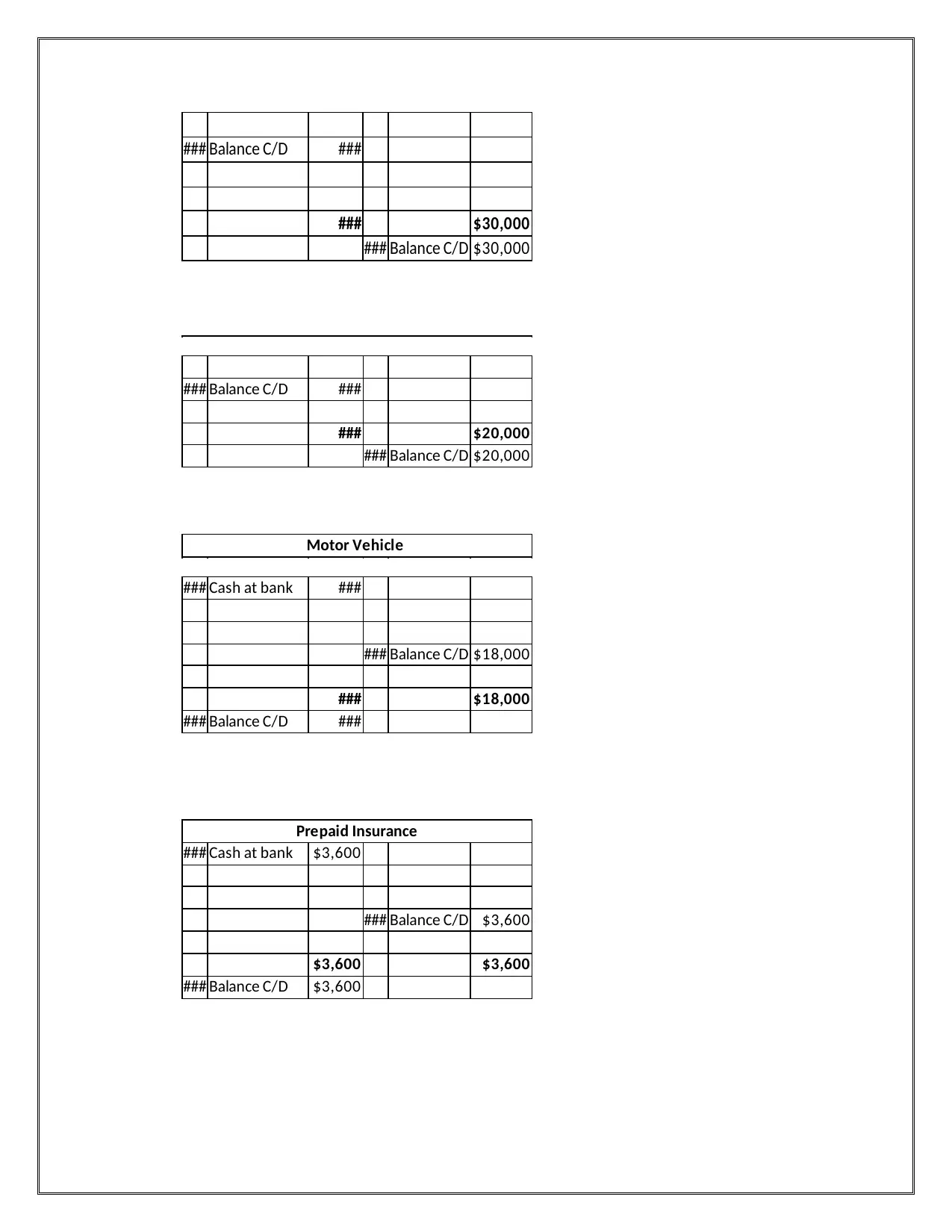
### Balance C/D ###
### $30,000
### Balance C/D $30,000
### Balance C/D ###
### $20,000
### Balance C/D $20,000
Motor Vehicle
### Cash at bank ###
### Balance C/D $18,000
### $18,000
### Balance C/D ###
Prepaid Insurance
### Cash at bank $3,600
### Balance C/D $3,600
$3,600 $3,600
### Balance C/D $3,600
### $30,000
### Balance C/D $30,000
### Balance C/D ###
### $20,000
### Balance C/D $20,000
Motor Vehicle
### Cash at bank ###
### Balance C/D $18,000
### $18,000
### Balance C/D ###
Prepaid Insurance
### Cash at bank $3,600
### Balance C/D $3,600
$3,600 $3,600
### Balance C/D $3,600
Secure Best Marks with AI Grader
Need help grading? Try our AI Grader for instant feedback on your assignments.

Cleaning Equipment
### Cash at bank $4,800
### Balance C/D $4,800
$4,800 $4,800
### Balance C/D $4,800
Cleaning Supplies
### $2,400
### Balance C/D $2,400
$2,400 $2,400
Account
Payable
### Balance C/D $2,400
Account Payable
### Cash at bank $2,000 ### $2,400
### Balance C/D $400
Cleaning
Supplies
Service Revenue
### $500
### Balance C/D $500
$500 $500
### Balance C/D $500
Cash at
bank
### Cash at bank $4,800
### Balance C/D $4,800
$4,800 $4,800
### Balance C/D $4,800
Cleaning Supplies
### $2,400
### Balance C/D $2,400
$2,400 $2,400
Account
Payable
### Balance C/D $2,400
Account Payable
### Cash at bank $2,000 ### $2,400
### Balance C/D $400
Cleaning
Supplies
Service Revenue
### $500
### Balance C/D $500
$500 $500
### Balance C/D $500
Cash at
bank
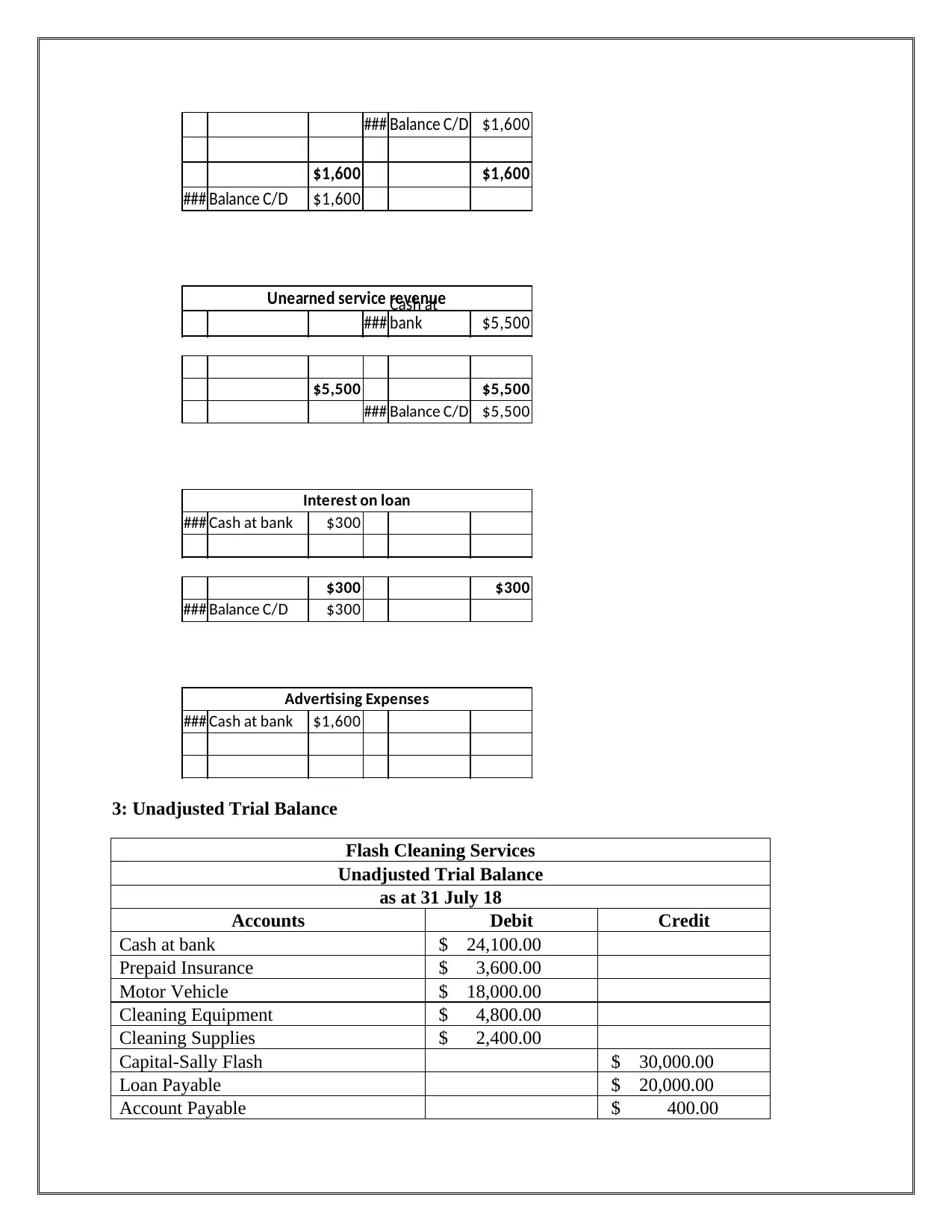
### Balance C/D $1,600
$1,600 $1,600
### Balance C/D $1,600
Unearned service revenue
### $5,500
Cash at
bank
$5,500 $5,500
### Balance C/D $5,500
Interest on loan
### Cash at bank $300
$300 $300
### Balance C/D $300
Advertising Expenses
### Cash at bank $1,600
3: Unadjusted Trial Balance
Flash Cleaning Services
Unadjusted Trial Balance
as at 31 July 18
Accounts Debit Credit
Cash at bank $ 24,100.00
Prepaid Insurance $ 3,600.00
Motor Vehicle $ 18,000.00
Cleaning Equipment $ 4,800.00
Cleaning Supplies $ 2,400.00
Capital-Sally Flash $ 30,000.00
Loan Payable $ 20,000.00
Account Payable $ 400.00
$1,600 $1,600
### Balance C/D $1,600
Unearned service revenue
### $5,500
Cash at
bank
$5,500 $5,500
### Balance C/D $5,500
Interest on loan
### Cash at bank $300
$300 $300
### Balance C/D $300
Advertising Expenses
### Cash at bank $1,600
3: Unadjusted Trial Balance
Flash Cleaning Services
Unadjusted Trial Balance
as at 31 July 18
Accounts Debit Credit
Cash at bank $ 24,100.00
Prepaid Insurance $ 3,600.00
Motor Vehicle $ 18,000.00
Cleaning Equipment $ 4,800.00
Cleaning Supplies $ 2,400.00
Capital-Sally Flash $ 30,000.00
Loan Payable $ 20,000.00
Account Payable $ 400.00
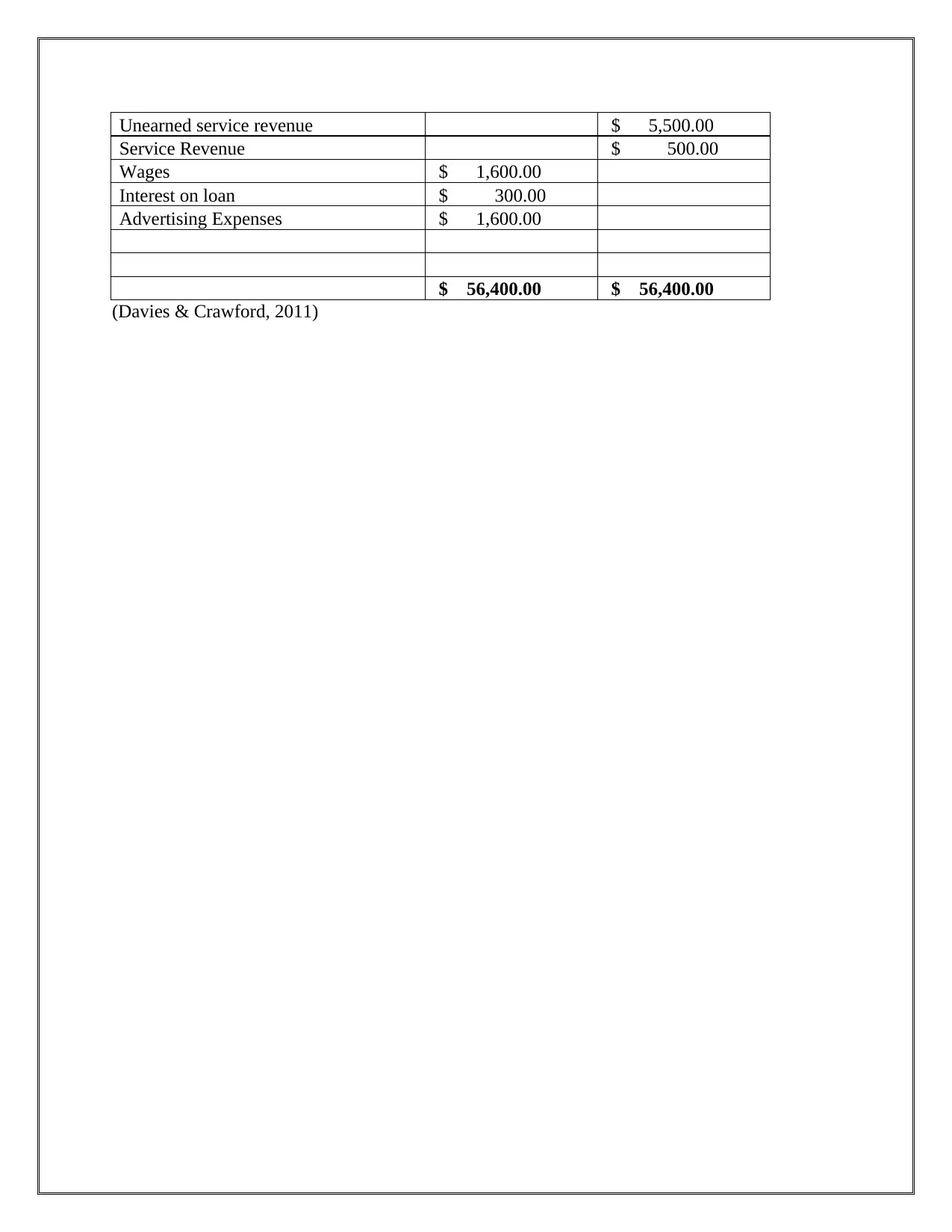
Unearned service revenue $ 5,500.00
Service Revenue $ 500.00
Wages $ 1,600.00
Interest on loan $ 300.00
Advertising Expenses $ 1,600.00
$ 56,400.00 $ 56,400.00
(Davies & Crawford, 2011)
Service Revenue $ 500.00
Wages $ 1,600.00
Interest on loan $ 300.00
Advertising Expenses $ 1,600.00
$ 56,400.00 $ 56,400.00
(Davies & Crawford, 2011)
Paraphrase This Document
Need a fresh take? Get an instant paraphrase of this document with our AI Paraphraser
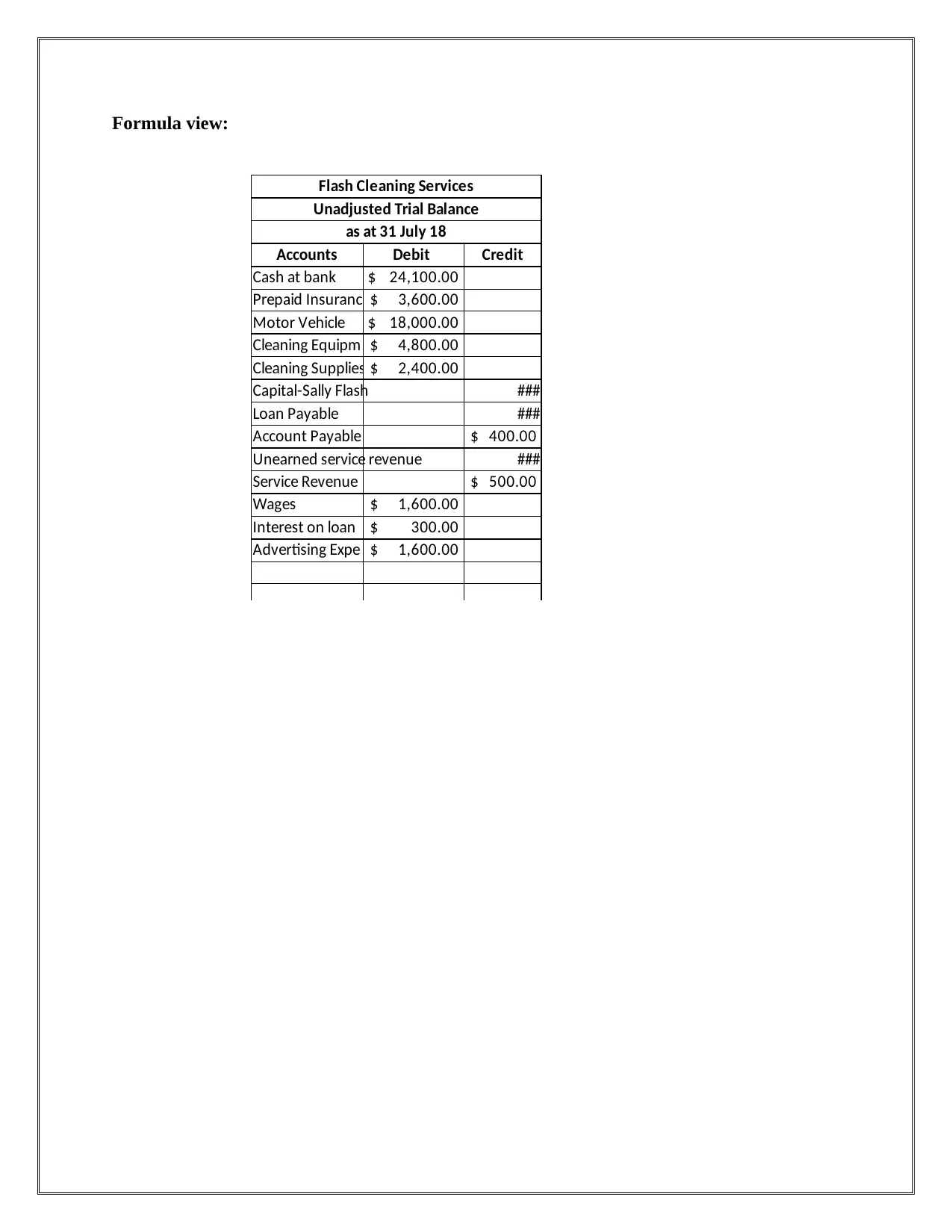
Formula view:
Flash Cleaning Services
Unadjusted Trial Balance
as at 31 July 18
Accounts Debit Credit
Cash at bank $ 24,100.00
Prepaid Insuranc $ 3,600.00
Motor Vehicle $ 18,000.00
Cleaning Equipm $ 4,800.00
Cleaning Supplies $ 2,400.00
Capital-Sally Flash ###
Loan Payable ###
Account Payable $ 400.00
Unearned service revenue ###
Service Revenue $ 500.00
Wages $ 1,600.00
Interest on loan $ 300.00
Advertising Expe $ 1,600.00
Flash Cleaning Services
Unadjusted Trial Balance
as at 31 July 18
Accounts Debit Credit
Cash at bank $ 24,100.00
Prepaid Insuranc $ 3,600.00
Motor Vehicle $ 18,000.00
Cleaning Equipm $ 4,800.00
Cleaning Supplies $ 2,400.00
Capital-Sally Flash ###
Loan Payable ###
Account Payable $ 400.00
Unearned service revenue ###
Service Revenue $ 500.00
Wages $ 1,600.00
Interest on loan $ 300.00
Advertising Expe $ 1,600.00
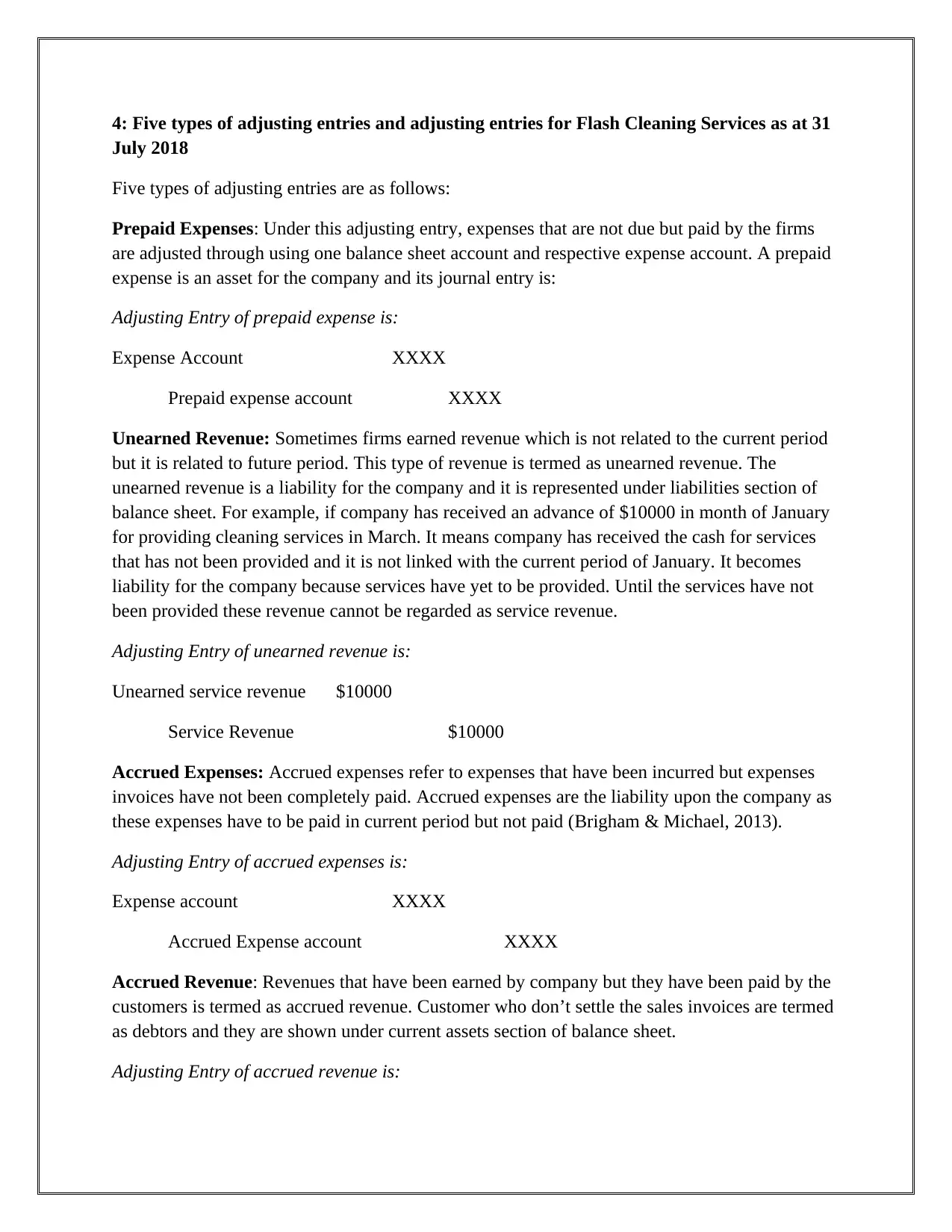
4: Five types of adjusting entries and adjusting entries for Flash Cleaning Services as at 31
July 2018
Five types of adjusting entries are as follows:
Prepaid Expenses: Under this adjusting entry, expenses that are not due but paid by the firms
are adjusted through using one balance sheet account and respective expense account. A prepaid
expense is an asset for the company and its journal entry is:
Adjusting Entry of prepaid expense is:
Expense Account XXXX
Prepaid expense account XXXX
Unearned Revenue: Sometimes firms earned revenue which is not related to the current period
but it is related to future period. This type of revenue is termed as unearned revenue. The
unearned revenue is a liability for the company and it is represented under liabilities section of
balance sheet. For example, if company has received an advance of $10000 in month of January
for providing cleaning services in March. It means company has received the cash for services
that has not been provided and it is not linked with the current period of January. It becomes
liability for the company because services have yet to be provided. Until the services have not
been provided these revenue cannot be regarded as service revenue.
Adjusting Entry of unearned revenue is:
Unearned service revenue $10000
Service Revenue $10000
Accrued Expenses: Accrued expenses refer to expenses that have been incurred but expenses
invoices have not been completely paid. Accrued expenses are the liability upon the company as
these expenses have to be paid in current period but not paid (Brigham & Michael, 2013).
Adjusting Entry of accrued expenses is:
Expense account XXXX
Accrued Expense account XXXX
Accrued Revenue: Revenues that have been earned by company but they have been paid by the
customers is termed as accrued revenue. Customer who don’t settle the sales invoices are termed
as debtors and they are shown under current assets section of balance sheet.
Adjusting Entry of accrued revenue is:
July 2018
Five types of adjusting entries are as follows:
Prepaid Expenses: Under this adjusting entry, expenses that are not due but paid by the firms
are adjusted through using one balance sheet account and respective expense account. A prepaid
expense is an asset for the company and its journal entry is:
Adjusting Entry of prepaid expense is:
Expense Account XXXX
Prepaid expense account XXXX
Unearned Revenue: Sometimes firms earned revenue which is not related to the current period
but it is related to future period. This type of revenue is termed as unearned revenue. The
unearned revenue is a liability for the company and it is represented under liabilities section of
balance sheet. For example, if company has received an advance of $10000 in month of January
for providing cleaning services in March. It means company has received the cash for services
that has not been provided and it is not linked with the current period of January. It becomes
liability for the company because services have yet to be provided. Until the services have not
been provided these revenue cannot be regarded as service revenue.
Adjusting Entry of unearned revenue is:
Unearned service revenue $10000
Service Revenue $10000
Accrued Expenses: Accrued expenses refer to expenses that have been incurred but expenses
invoices have not been completely paid. Accrued expenses are the liability upon the company as
these expenses have to be paid in current period but not paid (Brigham & Michael, 2013).
Adjusting Entry of accrued expenses is:
Expense account XXXX
Accrued Expense account XXXX
Accrued Revenue: Revenues that have been earned by company but they have been paid by the
customers is termed as accrued revenue. Customer who don’t settle the sales invoices are termed
as debtors and they are shown under current assets section of balance sheet.
Adjusting Entry of accrued revenue is:
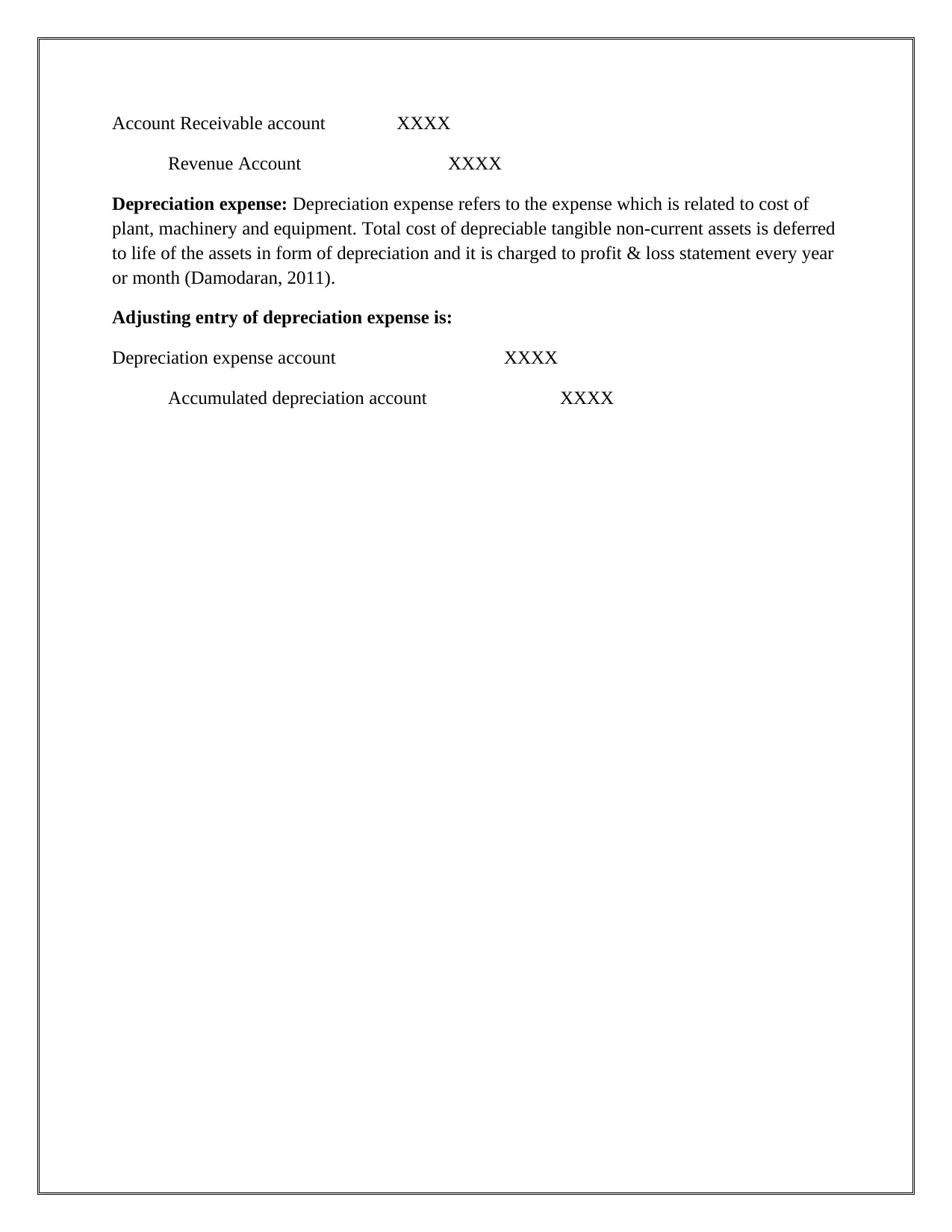
Account Receivable account XXXX
Revenue Account XXXX
Depreciation expense: Depreciation expense refers to the expense which is related to cost of
plant, machinery and equipment. Total cost of depreciable tangible non-current assets is deferred
to life of the assets in form of depreciation and it is charged to profit & loss statement every year
or month (Damodaran, 2011).
Adjusting entry of depreciation expense is:
Depreciation expense account XXXX
Accumulated depreciation account XXXX
Revenue Account XXXX
Depreciation expense: Depreciation expense refers to the expense which is related to cost of
plant, machinery and equipment. Total cost of depreciable tangible non-current assets is deferred
to life of the assets in form of depreciation and it is charged to profit & loss statement every year
or month (Damodaran, 2011).
Adjusting entry of depreciation expense is:
Depreciation expense account XXXX
Accumulated depreciation account XXXX
Secure Best Marks with AI Grader
Need help grading? Try our AI Grader for instant feedback on your assignments.
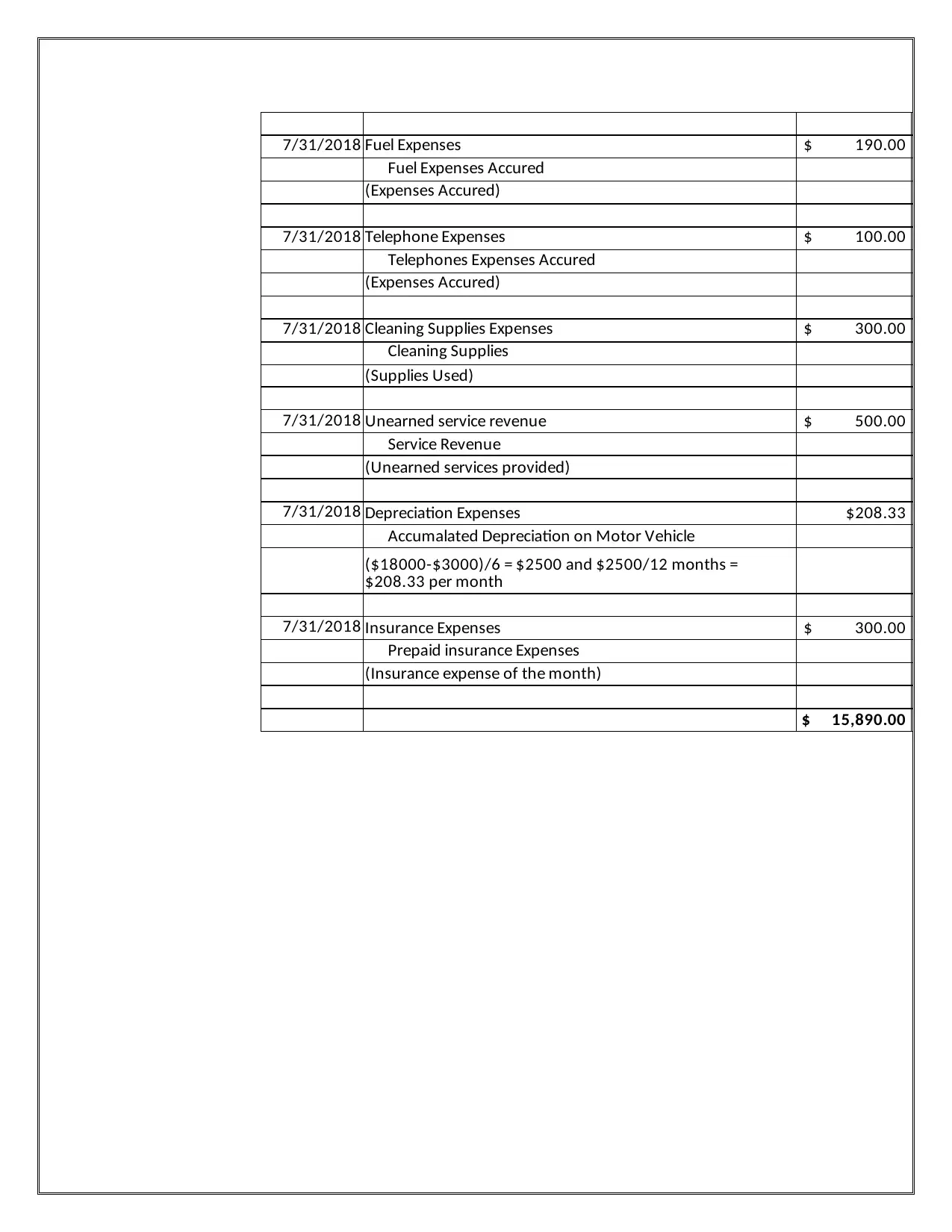
7/31/2018 Fuel Expenses $ 190.00
Fuel Expenses Accured
(Expenses Accured)
7/31/2018 Telephone Expenses $ 100.00
Telephones Expenses Accured
(Expenses Accured)
7/31/2018 Cleaning Supplies Expenses $ 300.00
Cleaning Supplies
(Supplies Used)
7/31/2018 Unearned service revenue $ 500.00
Service Revenue
(Unearned services provided)
7/31/2018 Depreciation Expenses $208.33
Accumalated Depreciation on Motor Vehicle
7/31/2018 Insurance Expenses $ 300.00
Prepaid insurance Expenses
(Insurance expense of the month)
$ 15,890.00
($18000-$3000)/6 = $2500 and $2500/12 months =
$208.33 per month
Fuel Expenses Accured
(Expenses Accured)
7/31/2018 Telephone Expenses $ 100.00
Telephones Expenses Accured
(Expenses Accured)
7/31/2018 Cleaning Supplies Expenses $ 300.00
Cleaning Supplies
(Supplies Used)
7/31/2018 Unearned service revenue $ 500.00
Service Revenue
(Unearned services provided)
7/31/2018 Depreciation Expenses $208.33
Accumalated Depreciation on Motor Vehicle
7/31/2018 Insurance Expenses $ 300.00
Prepaid insurance Expenses
(Insurance expense of the month)
$ 15,890.00
($18000-$3000)/6 = $2500 and $2500/12 months =
$208.33 per month
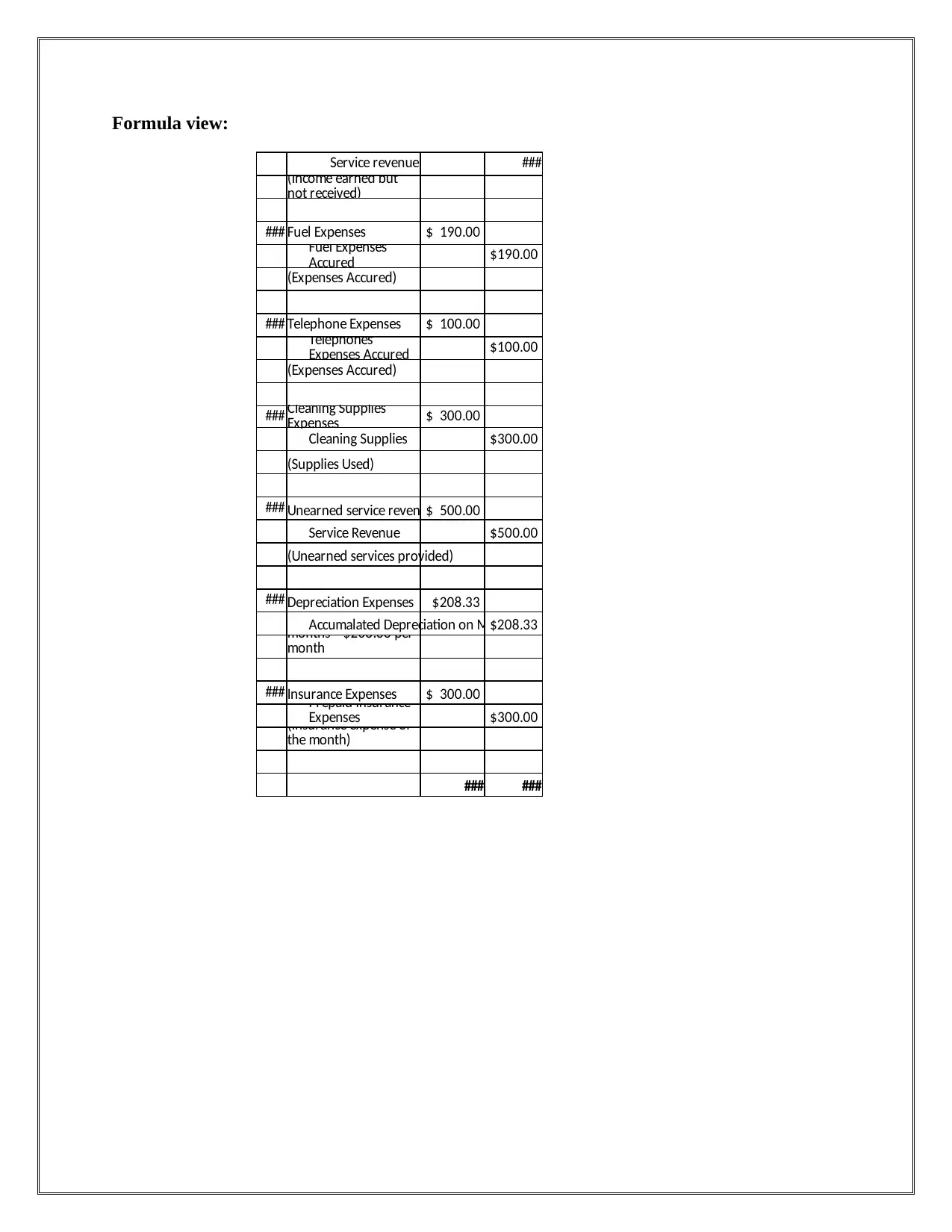
Formula view:
Service revenue ###
### Fuel Expenses $ 190.00
$190.00
(Expenses Accured)
### Telephone Expenses $ 100.00
$100.00
(Expenses Accured)
### $ 300.00
Cleaning Supplies $300.00
(Supplies Used)
### Unearned service reven $ 500.00
Service Revenue $500.00
(Unearned services provided)
### Depreciation Expenses $208.33
Accumalated Depreciation on M$208.33
### Insurance Expenses $ 300.00
$300.00
### ###
(Income earned but
not received)
Fuel Expenses
Accured
Telephones
Expenses Accured
Cleaning Supplies
Expenses
($18000-$3000)/6 =
$2500 and $2500/12
months = $208.33 per
month
Prepaid insurance
Expenses
(Insurance expense of
the month)
Service revenue ###
### Fuel Expenses $ 190.00
$190.00
(Expenses Accured)
### Telephone Expenses $ 100.00
$100.00
(Expenses Accured)
### $ 300.00
Cleaning Supplies $300.00
(Supplies Used)
### Unearned service reven $ 500.00
Service Revenue $500.00
(Unearned services provided)
### Depreciation Expenses $208.33
Accumalated Depreciation on M$208.33
### Insurance Expenses $ 300.00
$300.00
### ###
(Income earned but
not received)
Fuel Expenses
Accured
Telephones
Expenses Accured
Cleaning Supplies
Expenses
($18000-$3000)/6 =
$2500 and $2500/12
months = $208.33 per
month
Prepaid insurance
Expenses
(Insurance expense of
the month)
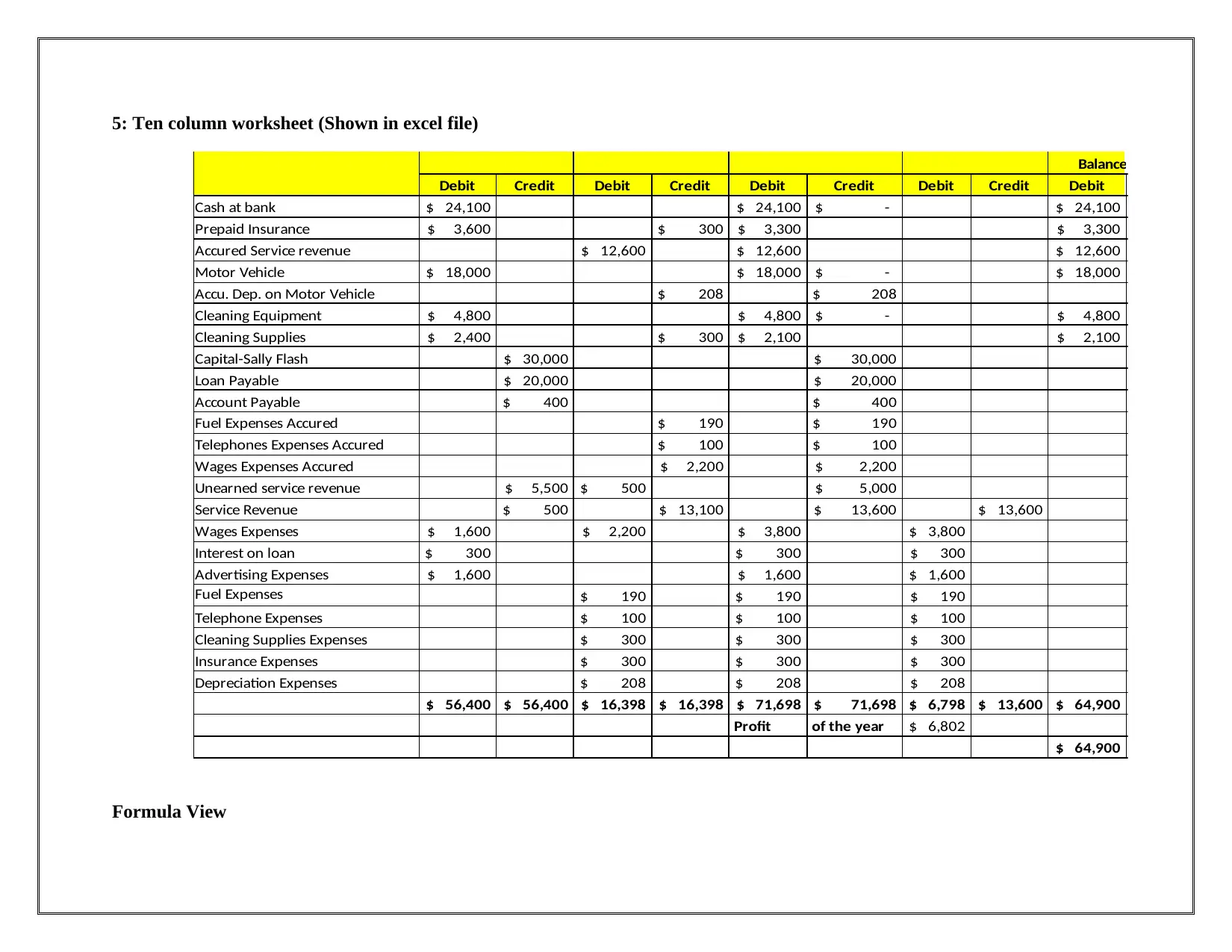
5: Ten column worksheet (Shown in excel file)
Trial Balance Adjustments Adjusted Trial Balance Income Statement
Balance Sheet
Debit Credit Debit Credit Debit Credit Debit Credit Debit
Cash at bank $ 24,100 $ 24,100 $ - $ 24,100
Prepaid Insurance $ 3,600 $ 300 $ 3,300 $ 3,300
Accured Service revenue $ 12,600 $ 12,600 $ 12,600
Motor Vehicle $ 18,000 $ 18,000 $ - $ 18,000
Accu. Dep. on Motor Vehicle $ 208 $ 208
Cleaning Equipment $ 4,800 $ 4,800 $ - $ 4,800
Cleaning Supplies $ 2,400 $ 300 $ 2,100 $ 2,100
Capital-Sally Flash $ 30,000 $ 30,000
Loan Payable $ 20,000 $ 20,000
Account Payable $ 400 $ 400
Fuel Expenses Accured $ 190 $ 190
Telephones Expenses Accured $ 100 $ 100
Wages Expenses Accured $ 2,200 $ 2,200
Unearned service revenue $ 5,500 $ 500 $ 5,000
Service Revenue $ 500 $ 13,100 $ 13,600 $ 13,600
Wages Expenses $ 1,600 $ 2,200 $ 3,800 $ 3,800
Interest on loan $ 300 $ 300 $ 300
Advertising Expenses $ 1,600 $ 1,600 $ 1,600
Fuel Expenses $ 190 $ 190 $ 190
Telephone Expenses $ 100 $ 100 $ 100
Cleaning Supplies Expenses $ 300 $ 300 $ 300
Insurance Expenses $ 300 $ 300 $ 300
Depreciation Expenses $ 208 $ 208 $ 208
$ 56,400 $ 56,400 $ 16,398 $ 16,398 $ 71,698 $ 71,698 $ 6,798 $ 13,600 $ 64,900
Profit of the year $ 6,802
$ 64,900
Formula View
Trial Balance Adjustments Adjusted Trial Balance Income Statement
Balance Sheet
Debit Credit Debit Credit Debit Credit Debit Credit Debit
Cash at bank $ 24,100 $ 24,100 $ - $ 24,100
Prepaid Insurance $ 3,600 $ 300 $ 3,300 $ 3,300
Accured Service revenue $ 12,600 $ 12,600 $ 12,600
Motor Vehicle $ 18,000 $ 18,000 $ - $ 18,000
Accu. Dep. on Motor Vehicle $ 208 $ 208
Cleaning Equipment $ 4,800 $ 4,800 $ - $ 4,800
Cleaning Supplies $ 2,400 $ 300 $ 2,100 $ 2,100
Capital-Sally Flash $ 30,000 $ 30,000
Loan Payable $ 20,000 $ 20,000
Account Payable $ 400 $ 400
Fuel Expenses Accured $ 190 $ 190
Telephones Expenses Accured $ 100 $ 100
Wages Expenses Accured $ 2,200 $ 2,200
Unearned service revenue $ 5,500 $ 500 $ 5,000
Service Revenue $ 500 $ 13,100 $ 13,600 $ 13,600
Wages Expenses $ 1,600 $ 2,200 $ 3,800 $ 3,800
Interest on loan $ 300 $ 300 $ 300
Advertising Expenses $ 1,600 $ 1,600 $ 1,600
Fuel Expenses $ 190 $ 190 $ 190
Telephone Expenses $ 100 $ 100 $ 100
Cleaning Supplies Expenses $ 300 $ 300 $ 300
Insurance Expenses $ 300 $ 300 $ 300
Depreciation Expenses $ 208 $ 208 $ 208
$ 56,400 $ 56,400 $ 16,398 $ 16,398 $ 71,698 $ 71,698 $ 6,798 $ 13,600 $ 64,900
Profit of the year $ 6,802
$ 64,900
Formula View
Paraphrase This Document
Need a fresh take? Get an instant paraphrase of this document with our AI Paraphraser
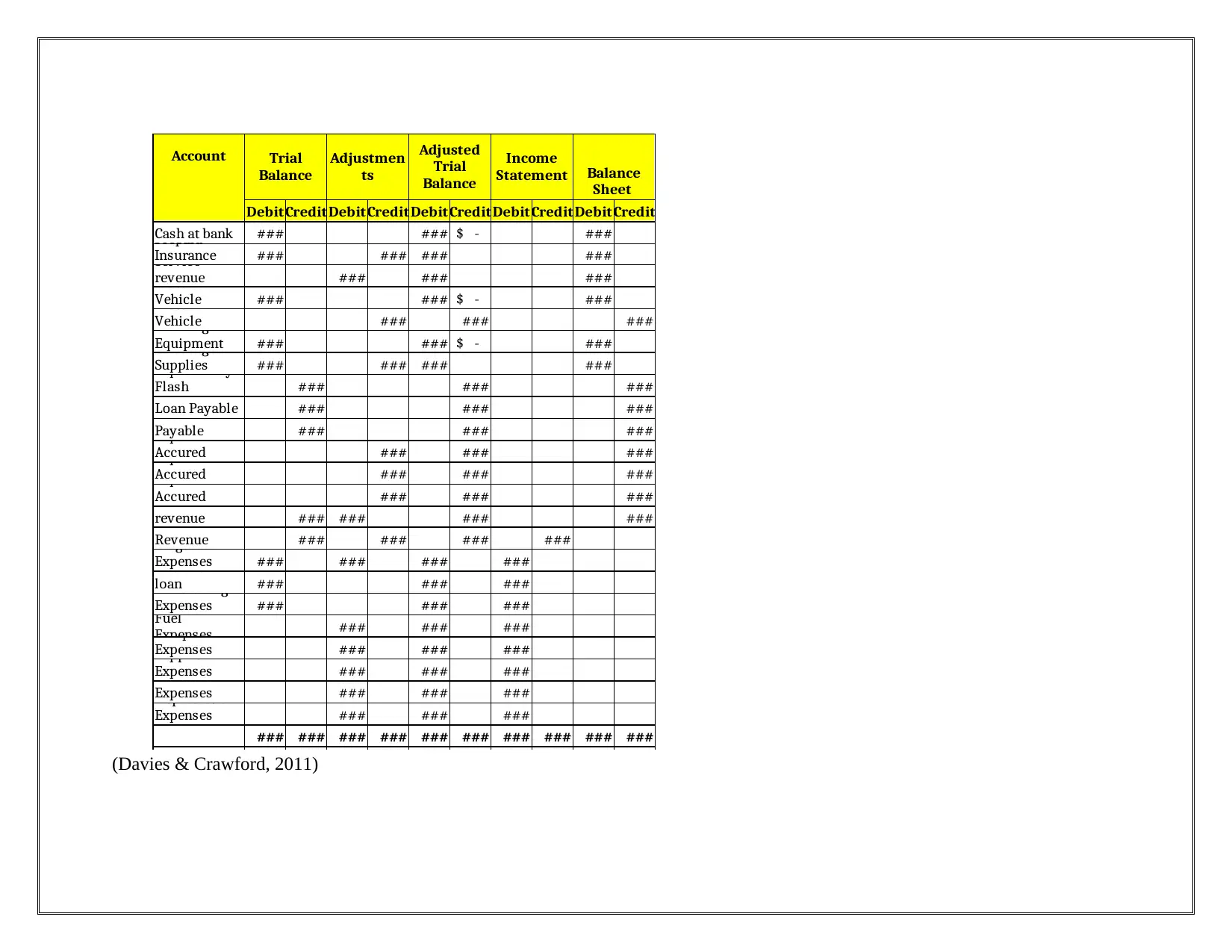
Account
DebitCreditDebitCreditDebitCreditDebitCreditDebitCredit
Cash at bank ### ### $ - ###
### ### ### ###
### ### ###
### ### $ - ###
### ### ###
### ### $ - ###
### ### ### ###
### ### ###
Loan Payable ### ### ###
### ### ###
### ### ###
### ### ###
### ### ###
### ### ### ###
### ### ### ###
### ### ### ###
### ### ###
### ### ###
### ### ###
### ### ###
### ### ###
### ### ###
### ### ###
### ### ### ### ### ### ### ### ### ###
Trial
Balance
Adjustmen
ts
Adjusted
Trial
Balance
Income
Statement Balance
Sheet
Prepaid
Insurance
Accured
Service
revenueMotor
Vehicle
Accu. Dep. on
Motor
VehicleCleaning
EquipmentCleaning
SuppliesCapital-Sally
Flash
Account
Payable
Fuel
Expenses
Accured
Telephones
Expenses
Accured
Wages
Expenses
Accured
Unearned
service
revenueService
RevenueWages
ExpensesInterest on
loanAdvertising
Expenses
Fuel
ExpensesTelephone
Expenses
Cleaning
Supplies
ExpensesInsurance
ExpensesDepreciation
Expenses
(Davies & Crawford, 2011)
DebitCreditDebitCreditDebitCreditDebitCreditDebitCredit
Cash at bank ### ### $ - ###
### ### ### ###
### ### ###
### ### $ - ###
### ### ###
### ### $ - ###
### ### ### ###
### ### ###
Loan Payable ### ### ###
### ### ###
### ### ###
### ### ###
### ### ###
### ### ### ###
### ### ### ###
### ### ### ###
### ### ###
### ### ###
### ### ###
### ### ###
### ### ###
### ### ###
### ### ###
### ### ### ### ### ### ### ### ### ###
Trial
Balance
Adjustmen
ts
Adjusted
Trial
Balance
Income
Statement Balance
Sheet
Prepaid
Insurance
Accured
Service
revenueMotor
Vehicle
Accu. Dep. on
Motor
VehicleCleaning
EquipmentCleaning
SuppliesCapital-Sally
Flash
Account
Payable
Fuel
Expenses
Accured
Telephones
Expenses
Accured
Wages
Expenses
Accured
Unearned
service
revenueService
RevenueWages
ExpensesInterest on
loanAdvertising
Expenses
Fuel
ExpensesTelephone
Expenses
Cleaning
Supplies
ExpensesInsurance
ExpensesDepreciation
Expenses
(Davies & Crawford, 2011)
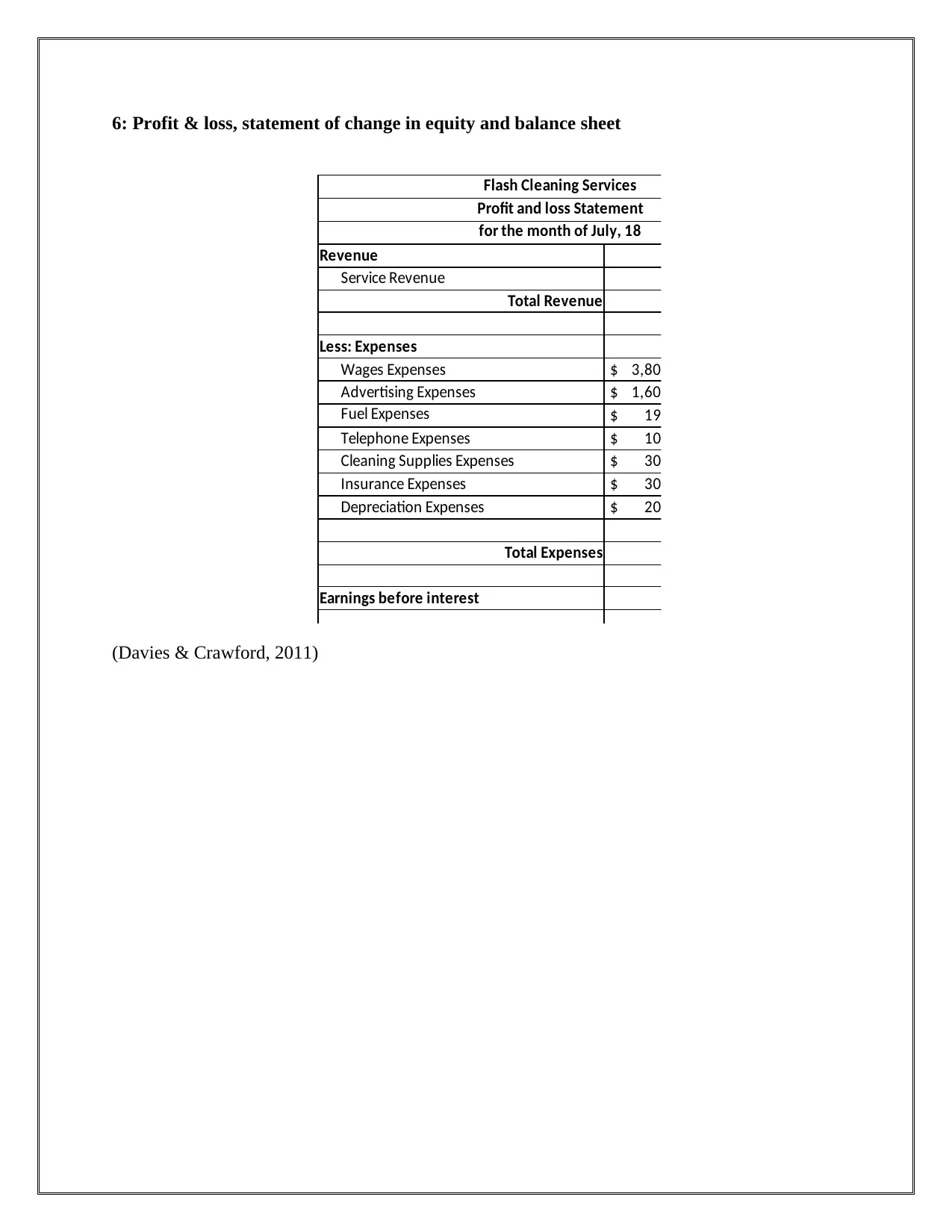
6: Profit & loss, statement of change in equity and balance sheet
Flash Cleaning Services
Profit and loss Statement
for the month of July, 18
Revenue
Service Revenue
Total Revenue
Less: Expenses
Wages Expenses $ 3,800.00
Advertising Expenses $ 1,600.00
Fuel Expenses $ 190.00
Telephone Expenses $ 100.00
Cleaning Supplies Expenses $ 300.00
Insurance Expenses $ 300.00
Depreciation Expenses $ 208.33
Total Expenses
Earnings before interest
(Davies & Crawford, 2011)
Flash Cleaning Services
Profit and loss Statement
for the month of July, 18
Revenue
Service Revenue
Total Revenue
Less: Expenses
Wages Expenses $ 3,800.00
Advertising Expenses $ 1,600.00
Fuel Expenses $ 190.00
Telephone Expenses $ 100.00
Cleaning Supplies Expenses $ 300.00
Insurance Expenses $ 300.00
Depreciation Expenses $ 208.33
Total Expenses
Earnings before interest
(Davies & Crawford, 2011)
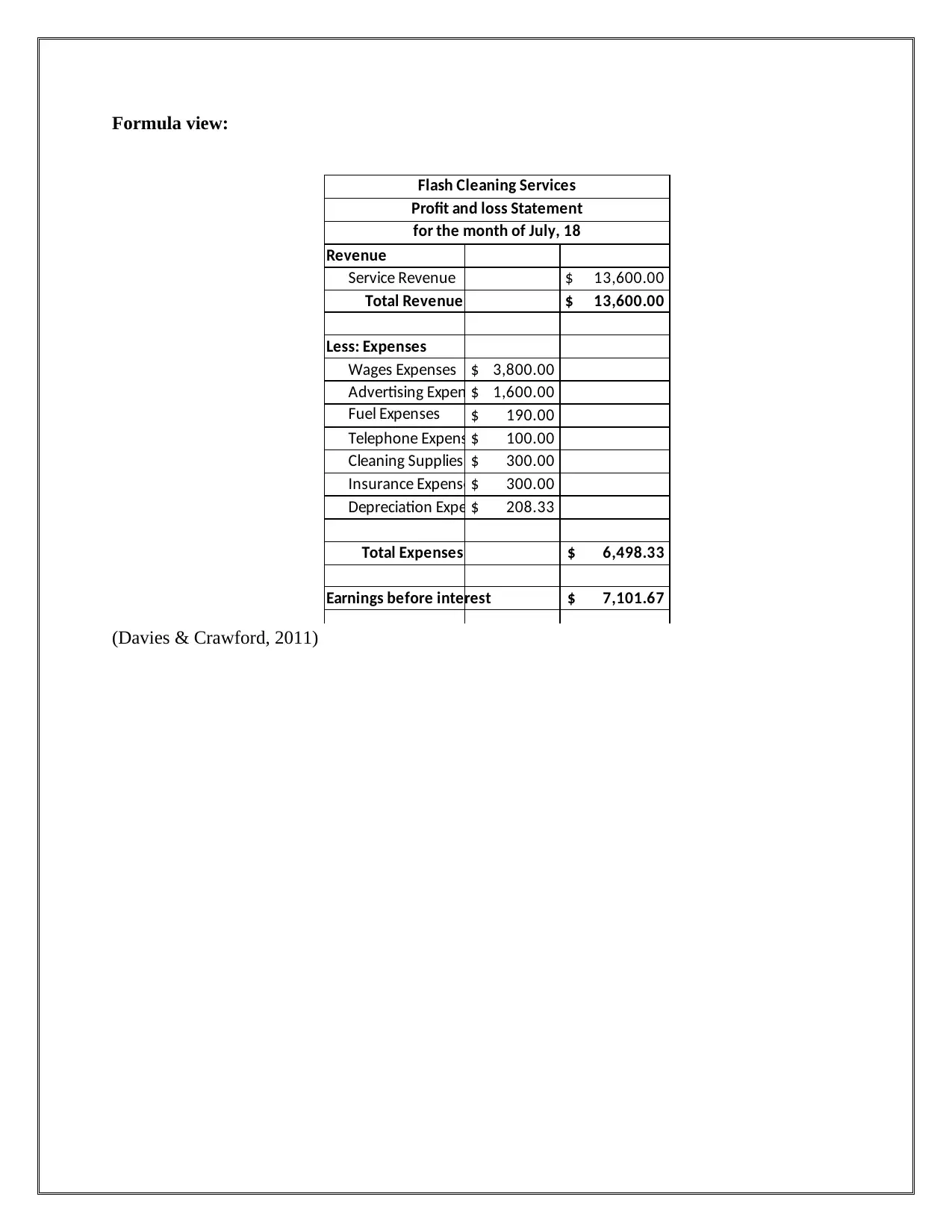
Formula view:
Flash Cleaning Services
Profit and loss Statement
for the month of July, 18
Revenue
Service Revenue $ 13,600.00
Total Revenue $ 13,600.00
Less: Expenses
Wages Expenses $ 3,800.00
Advertising Expen $ 1,600.00
Fuel Expenses $ 190.00
Telephone Expens $ 100.00
Cleaning Supplies $ 300.00
Insurance Expense$ 300.00
Depreciation Expe $ 208.33
Total Expenses $ 6,498.33
Earnings before interest $ 7,101.67
(Davies & Crawford, 2011)
Flash Cleaning Services
Profit and loss Statement
for the month of July, 18
Revenue
Service Revenue $ 13,600.00
Total Revenue $ 13,600.00
Less: Expenses
Wages Expenses $ 3,800.00
Advertising Expen $ 1,600.00
Fuel Expenses $ 190.00
Telephone Expens $ 100.00
Cleaning Supplies $ 300.00
Insurance Expense$ 300.00
Depreciation Expe $ 208.33
Total Expenses $ 6,498.33
Earnings before interest $ 7,101.67
(Davies & Crawford, 2011)
Secure Best Marks with AI Grader
Need help grading? Try our AI Grader for instant feedback on your assignments.
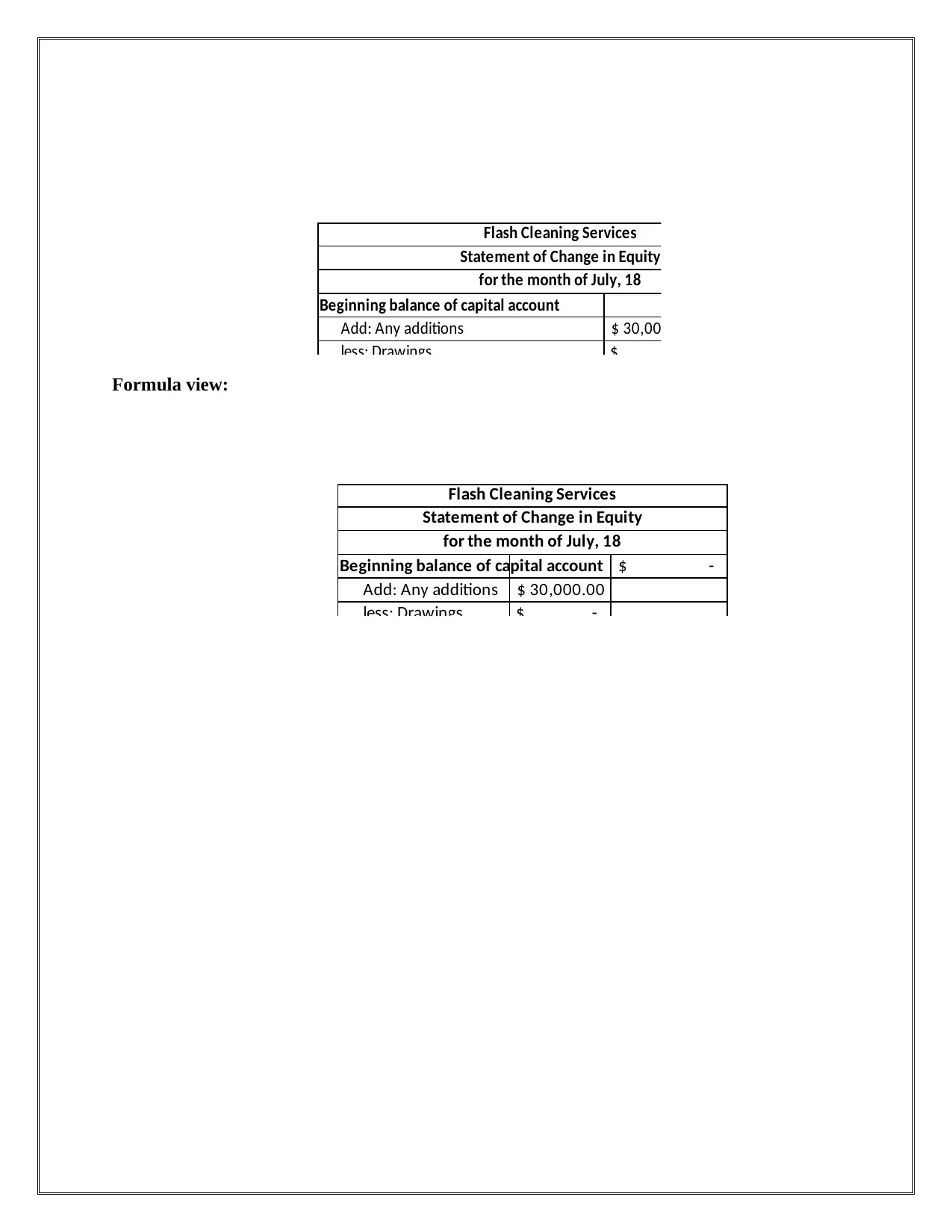
Flash Cleaning Services
Statement of Change in Equity
for the month of July, 18
Beginning balance of capital account
Add: Any additions $ 30,000.00
less: Drawings $ -
Formula view:
Flash Cleaning Services
Statement of Change in Equity
for the month of July, 18
Beginning balance of capital account $ -
Add: Any additions $ 30,000.00
less: Drawings $ -
Statement of Change in Equity
for the month of July, 18
Beginning balance of capital account
Add: Any additions $ 30,000.00
less: Drawings $ -
Formula view:
Flash Cleaning Services
Statement of Change in Equity
for the month of July, 18
Beginning balance of capital account $ -
Add: Any additions $ 30,000.00
less: Drawings $ -

Current Liabilities
Account Payable $ 400.00
Fuel Expenses Accured $ 190.00
Telephones Expenses Accured $ 100.00
Wages Expenses Accured $ 2,200.00
Unearned service revenue $ 5,000.00
Total Current Liabilities
Non Current Liabilities
Loan Payable $ 20,000.00
Total Non Current Liabilities
Equity
Capital-Sally Flash $ 30,000.00
Retained Earnings $ 6,801.67
Total Equity
Total Liabilities and Equity
Account Payable $ 400.00
Fuel Expenses Accured $ 190.00
Telephones Expenses Accured $ 100.00
Wages Expenses Accured $ 2,200.00
Unearned service revenue $ 5,000.00
Total Current Liabilities
Non Current Liabilities
Loan Payable $ 20,000.00
Total Non Current Liabilities
Equity
Capital-Sally Flash $ 30,000.00
Retained Earnings $ 6,801.67
Total Equity
Total Liabilities and Equity
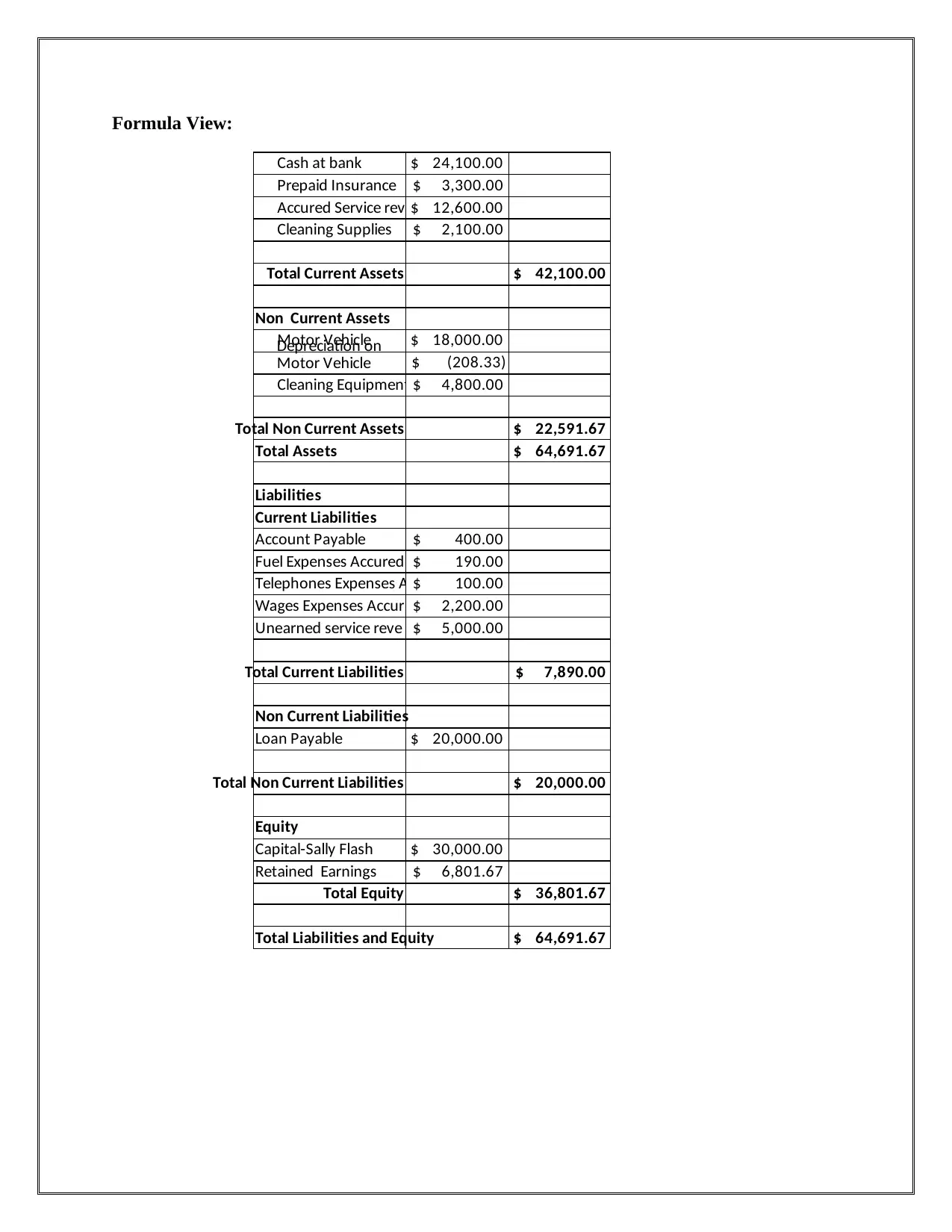
Formula View:
Cash at bank $ 24,100.00
Prepaid Insurance $ 3,300.00
Accured Service rev $ 12,600.00
Cleaning Supplies $ 2,100.00
Total Current Assets $ 42,100.00
Non Current Assets
Motor Vehicle $ 18,000.00
$ (208.33)
Cleaning Equipment $ 4,800.00
Total Non Current Assets $ 22,591.67
Total Assets $ 64,691.67
Liabilities
Current Liabilities
Account Payable $ 400.00
Fuel Expenses Accured $ 190.00
Telephones Expenses A $ 100.00
Wages Expenses Accur $ 2,200.00
Unearned service reve $ 5,000.00
Total Current Liabilities $ 7,890.00
Non Current Liabilities
Loan Payable $ 20,000.00
Total Non Current Liabilities $ 20,000.00
Equity
Capital-Sally Flash $ 30,000.00
Retained Earnings $ 6,801.67
Total Equity $ 36,801.67
Total Liabilities and Equity $ 64,691.67
Depreciation on
Motor Vehicle
Cash at bank $ 24,100.00
Prepaid Insurance $ 3,300.00
Accured Service rev $ 12,600.00
Cleaning Supplies $ 2,100.00
Total Current Assets $ 42,100.00
Non Current Assets
Motor Vehicle $ 18,000.00
$ (208.33)
Cleaning Equipment $ 4,800.00
Total Non Current Assets $ 22,591.67
Total Assets $ 64,691.67
Liabilities
Current Liabilities
Account Payable $ 400.00
Fuel Expenses Accured $ 190.00
Telephones Expenses A $ 100.00
Wages Expenses Accur $ 2,200.00
Unearned service reve $ 5,000.00
Total Current Liabilities $ 7,890.00
Non Current Liabilities
Loan Payable $ 20,000.00
Total Non Current Liabilities $ 20,000.00
Equity
Capital-Sally Flash $ 30,000.00
Retained Earnings $ 6,801.67
Total Equity $ 36,801.67
Total Liabilities and Equity $ 64,691.67
Depreciation on
Motor Vehicle
Paraphrase This Document
Need a fresh take? Get an instant paraphrase of this document with our AI Paraphraser
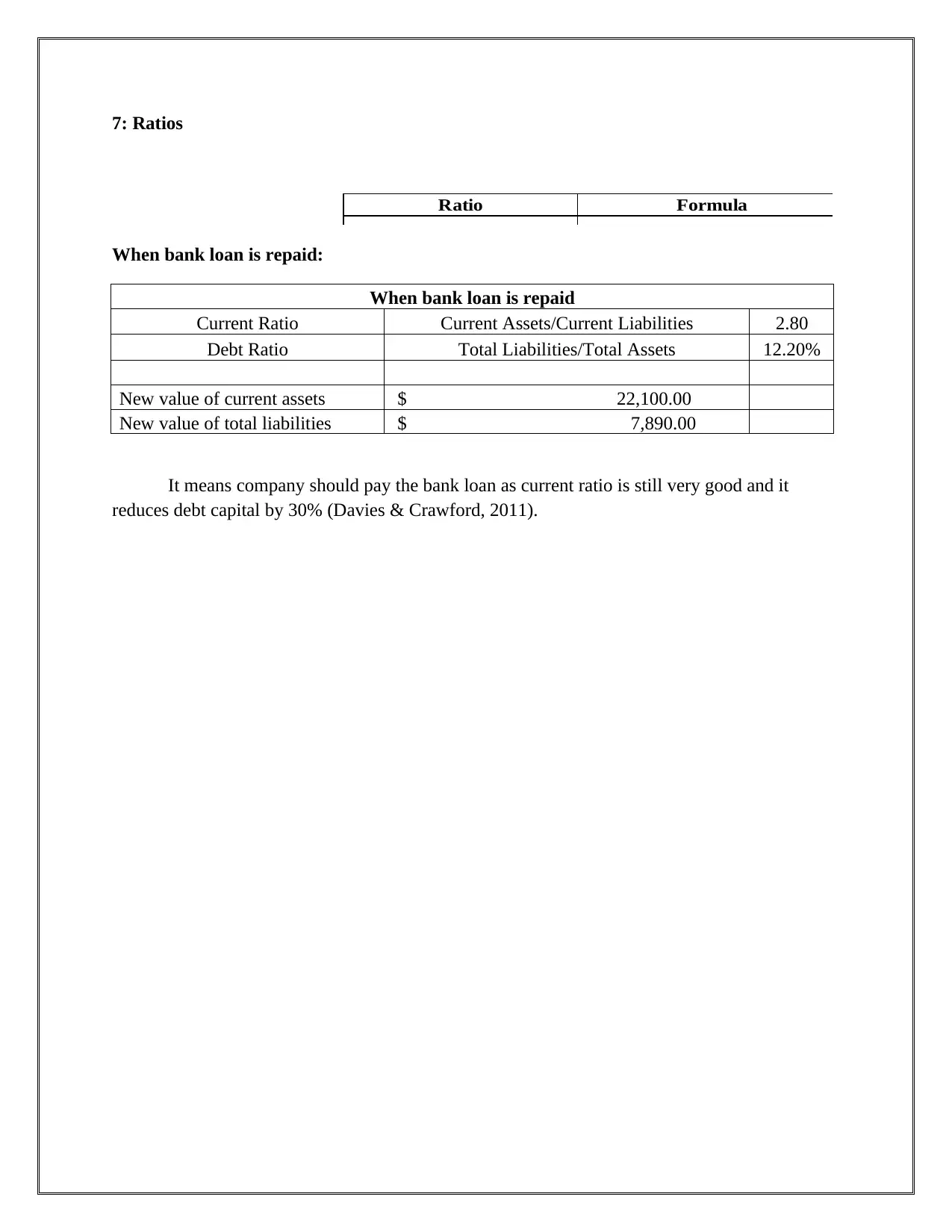
7: Ratios
Ratio Formula
When bank loan is repaid:
When bank loan is repaid
Current Ratio Current Assets/Current Liabilities 2.80
Debt Ratio Total Liabilities/Total Assets 12.20%
New value of current assets $ 22,100.00
New value of total liabilities $ 7,890.00
It means company should pay the bank loan as current ratio is still very good and it
reduces debt capital by 30% (Davies & Crawford, 2011).
Ratio Formula
When bank loan is repaid:
When bank loan is repaid
Current Ratio Current Assets/Current Liabilities 2.80
Debt Ratio Total Liabilities/Total Assets 12.20%
New value of current assets $ 22,100.00
New value of total liabilities $ 7,890.00
It means company should pay the bank loan as current ratio is still very good and it
reduces debt capital by 30% (Davies & Crawford, 2011).
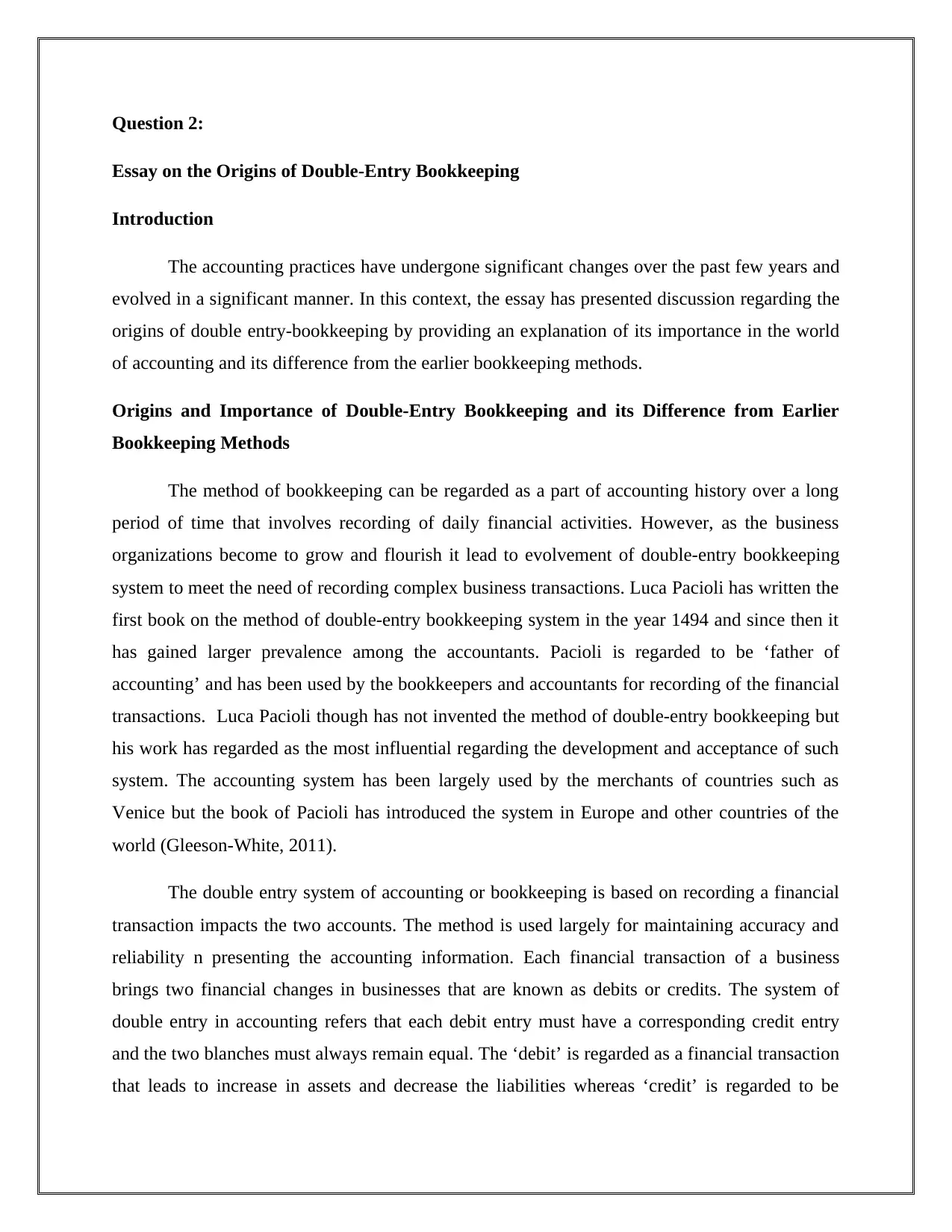
Question 2:
Essay on the Origins of Double-Entry Bookkeeping
Introduction
The accounting practices have undergone significant changes over the past few years and
evolved in a significant manner. In this context, the essay has presented discussion regarding the
origins of double entry-bookkeeping by providing an explanation of its importance in the world
of accounting and its difference from the earlier bookkeeping methods.
Origins and Importance of Double-Entry Bookkeeping and its Difference from Earlier
Bookkeeping Methods
The method of bookkeeping can be regarded as a part of accounting history over a long
period of time that involves recording of daily financial activities. However, as the business
organizations become to grow and flourish it lead to evolvement of double-entry bookkeeping
system to meet the need of recording complex business transactions. Luca Pacioli has written the
first book on the method of double-entry bookkeeping system in the year 1494 and since then it
has gained larger prevalence among the accountants. Pacioli is regarded to be ‘father of
accounting’ and has been used by the bookkeepers and accountants for recording of the financial
transactions. Luca Pacioli though has not invented the method of double-entry bookkeeping but
his work has regarded as the most influential regarding the development and acceptance of such
system. The accounting system has been largely used by the merchants of countries such as
Venice but the book of Pacioli has introduced the system in Europe and other countries of the
world (Gleeson-White, 2011).
The double entry system of accounting or bookkeeping is based on recording a financial
transaction impacts the two accounts. The method is used largely for maintaining accuracy and
reliability n presenting the accounting information. Each financial transaction of a business
brings two financial changes in businesses that are known as debits or credits. The system of
double entry in accounting refers that each debit entry must have a corresponding credit entry
and the two blanches must always remain equal. The ‘debit’ is regarded as a financial transaction
that leads to increase in assets and decrease the liabilities whereas ‘credit’ is regarded to be
Essay on the Origins of Double-Entry Bookkeeping
Introduction
The accounting practices have undergone significant changes over the past few years and
evolved in a significant manner. In this context, the essay has presented discussion regarding the
origins of double entry-bookkeeping by providing an explanation of its importance in the world
of accounting and its difference from the earlier bookkeeping methods.
Origins and Importance of Double-Entry Bookkeeping and its Difference from Earlier
Bookkeeping Methods
The method of bookkeeping can be regarded as a part of accounting history over a long
period of time that involves recording of daily financial activities. However, as the business
organizations become to grow and flourish it lead to evolvement of double-entry bookkeeping
system to meet the need of recording complex business transactions. Luca Pacioli has written the
first book on the method of double-entry bookkeeping system in the year 1494 and since then it
has gained larger prevalence among the accountants. Pacioli is regarded to be ‘father of
accounting’ and has been used by the bookkeepers and accountants for recording of the financial
transactions. Luca Pacioli though has not invented the method of double-entry bookkeeping but
his work has regarded as the most influential regarding the development and acceptance of such
system. The accounting system has been largely used by the merchants of countries such as
Venice but the book of Pacioli has introduced the system in Europe and other countries of the
world (Gleeson-White, 2011).
The double entry system of accounting or bookkeeping is based on recording a financial
transaction impacts the two accounts. The method is used largely for maintaining accuracy and
reliability n presenting the accounting information. Each financial transaction of a business
brings two financial changes in businesses that are known as debits or credits. The system of
double entry in accounting refers that each debit entry must have a corresponding credit entry
and the two blanches must always remain equal. The ‘debit’ is regarded as a financial transaction
that leads to increase in assets and decrease the liabilities whereas ‘credit’ is regarded to be
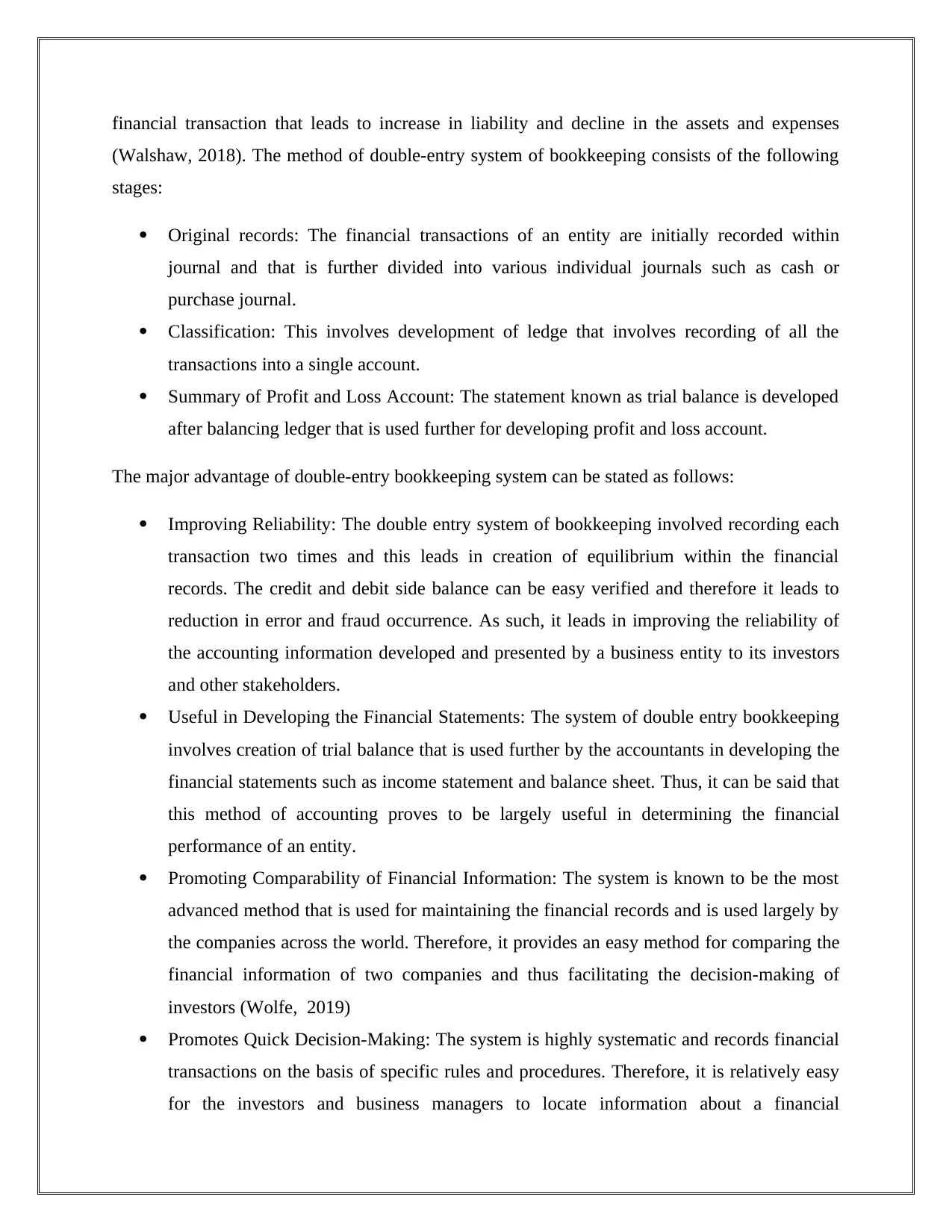
financial transaction that leads to increase in liability and decline in the assets and expenses
(Walshaw, 2018). The method of double-entry system of bookkeeping consists of the following
stages:
Original records: The financial transactions of an entity are initially recorded within
journal and that is further divided into various individual journals such as cash or
purchase journal.
Classification: This involves development of ledge that involves recording of all the
transactions into a single account.
Summary of Profit and Loss Account: The statement known as trial balance is developed
after balancing ledger that is used further for developing profit and loss account.
The major advantage of double-entry bookkeeping system can be stated as follows:
Improving Reliability: The double entry system of bookkeeping involved recording each
transaction two times and this leads in creation of equilibrium within the financial
records. The credit and debit side balance can be easy verified and therefore it leads to
reduction in error and fraud occurrence. As such, it leads in improving the reliability of
the accounting information developed and presented by a business entity to its investors
and other stakeholders.
Useful in Developing the Financial Statements: The system of double entry bookkeeping
involves creation of trial balance that is used further by the accountants in developing the
financial statements such as income statement and balance sheet. Thus, it can be said that
this method of accounting proves to be largely useful in determining the financial
performance of an entity.
Promoting Comparability of Financial Information: The system is known to be the most
advanced method that is used for maintaining the financial records and is used largely by
the companies across the world. Therefore, it provides an easy method for comparing the
financial information of two companies and thus facilitating the decision-making of
investors (Wolfe, 2019)
Promotes Quick Decision-Making: The system is highly systematic and records financial
transactions on the basis of specific rules and procedures. Therefore, it is relatively easy
for the investors and business managers to locate information about a financial
(Walshaw, 2018). The method of double-entry system of bookkeeping consists of the following
stages:
Original records: The financial transactions of an entity are initially recorded within
journal and that is further divided into various individual journals such as cash or
purchase journal.
Classification: This involves development of ledge that involves recording of all the
transactions into a single account.
Summary of Profit and Loss Account: The statement known as trial balance is developed
after balancing ledger that is used further for developing profit and loss account.
The major advantage of double-entry bookkeeping system can be stated as follows:
Improving Reliability: The double entry system of bookkeeping involved recording each
transaction two times and this leads in creation of equilibrium within the financial
records. The credit and debit side balance can be easy verified and therefore it leads to
reduction in error and fraud occurrence. As such, it leads in improving the reliability of
the accounting information developed and presented by a business entity to its investors
and other stakeholders.
Useful in Developing the Financial Statements: The system of double entry bookkeeping
involves creation of trial balance that is used further by the accountants in developing the
financial statements such as income statement and balance sheet. Thus, it can be said that
this method of accounting proves to be largely useful in determining the financial
performance of an entity.
Promoting Comparability of Financial Information: The system is known to be the most
advanced method that is used for maintaining the financial records and is used largely by
the companies across the world. Therefore, it provides an easy method for comparing the
financial information of two companies and thus facilitating the decision-making of
investors (Wolfe, 2019)
Promotes Quick Decision-Making: The system is highly systematic and records financial
transactions on the basis of specific rules and procedures. Therefore, it is relatively easy
for the investors and business managers to locate information about a financial
Secure Best Marks with AI Grader
Need help grading? Try our AI Grader for instant feedback on your assignments.
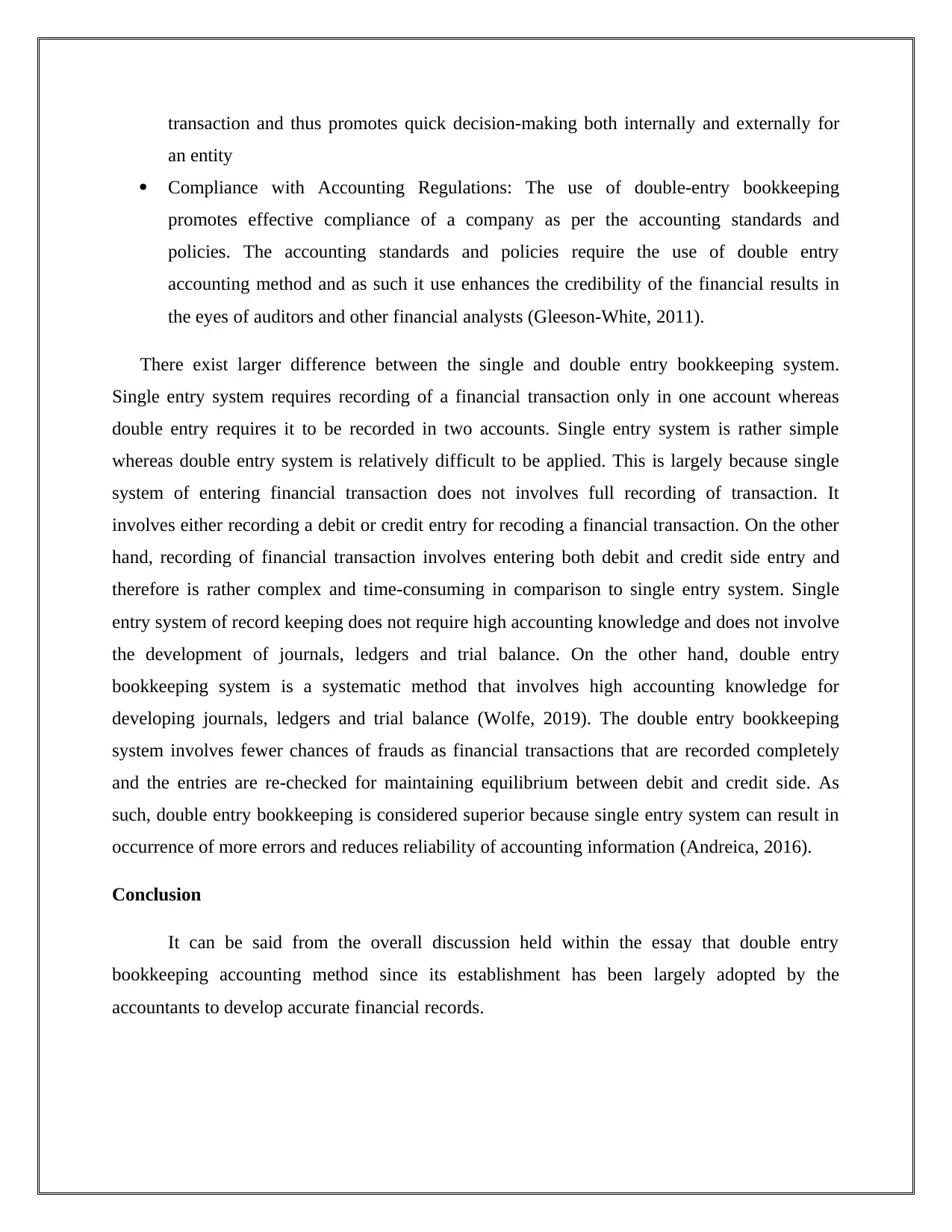
transaction and thus promotes quick decision-making both internally and externally for
an entity
Compliance with Accounting Regulations: The use of double-entry bookkeeping
promotes effective compliance of a company as per the accounting standards and
policies. The accounting standards and policies require the use of double entry
accounting method and as such it use enhances the credibility of the financial results in
the eyes of auditors and other financial analysts (Gleeson-White, 2011).
There exist larger difference between the single and double entry bookkeeping system.
Single entry system requires recording of a financial transaction only in one account whereas
double entry requires it to be recorded in two accounts. Single entry system is rather simple
whereas double entry system is relatively difficult to be applied. This is largely because single
system of entering financial transaction does not involves full recording of transaction. It
involves either recording a debit or credit entry for recoding a financial transaction. On the other
hand, recording of financial transaction involves entering both debit and credit side entry and
therefore is rather complex and time-consuming in comparison to single entry system. Single
entry system of record keeping does not require high accounting knowledge and does not involve
the development of journals, ledgers and trial balance. On the other hand, double entry
bookkeeping system is a systematic method that involves high accounting knowledge for
developing journals, ledgers and trial balance (Wolfe, 2019). The double entry bookkeeping
system involves fewer chances of frauds as financial transactions that are recorded completely
and the entries are re-checked for maintaining equilibrium between debit and credit side. As
such, double entry bookkeeping is considered superior because single entry system can result in
occurrence of more errors and reduces reliability of accounting information (Andreica, 2016).
Conclusion
It can be said from the overall discussion held within the essay that double entry
bookkeeping accounting method since its establishment has been largely adopted by the
accountants to develop accurate financial records.
an entity
Compliance with Accounting Regulations: The use of double-entry bookkeeping
promotes effective compliance of a company as per the accounting standards and
policies. The accounting standards and policies require the use of double entry
accounting method and as such it use enhances the credibility of the financial results in
the eyes of auditors and other financial analysts (Gleeson-White, 2011).
There exist larger difference between the single and double entry bookkeeping system.
Single entry system requires recording of a financial transaction only in one account whereas
double entry requires it to be recorded in two accounts. Single entry system is rather simple
whereas double entry system is relatively difficult to be applied. This is largely because single
system of entering financial transaction does not involves full recording of transaction. It
involves either recording a debit or credit entry for recoding a financial transaction. On the other
hand, recording of financial transaction involves entering both debit and credit side entry and
therefore is rather complex and time-consuming in comparison to single entry system. Single
entry system of record keeping does not require high accounting knowledge and does not involve
the development of journals, ledgers and trial balance. On the other hand, double entry
bookkeeping system is a systematic method that involves high accounting knowledge for
developing journals, ledgers and trial balance (Wolfe, 2019). The double entry bookkeeping
system involves fewer chances of frauds as financial transactions that are recorded completely
and the entries are re-checked for maintaining equilibrium between debit and credit side. As
such, double entry bookkeeping is considered superior because single entry system can result in
occurrence of more errors and reduces reliability of accounting information (Andreica, 2016).
Conclusion
It can be said from the overall discussion held within the essay that double entry
bookkeeping accounting method since its establishment has been largely adopted by the
accountants to develop accurate financial records.
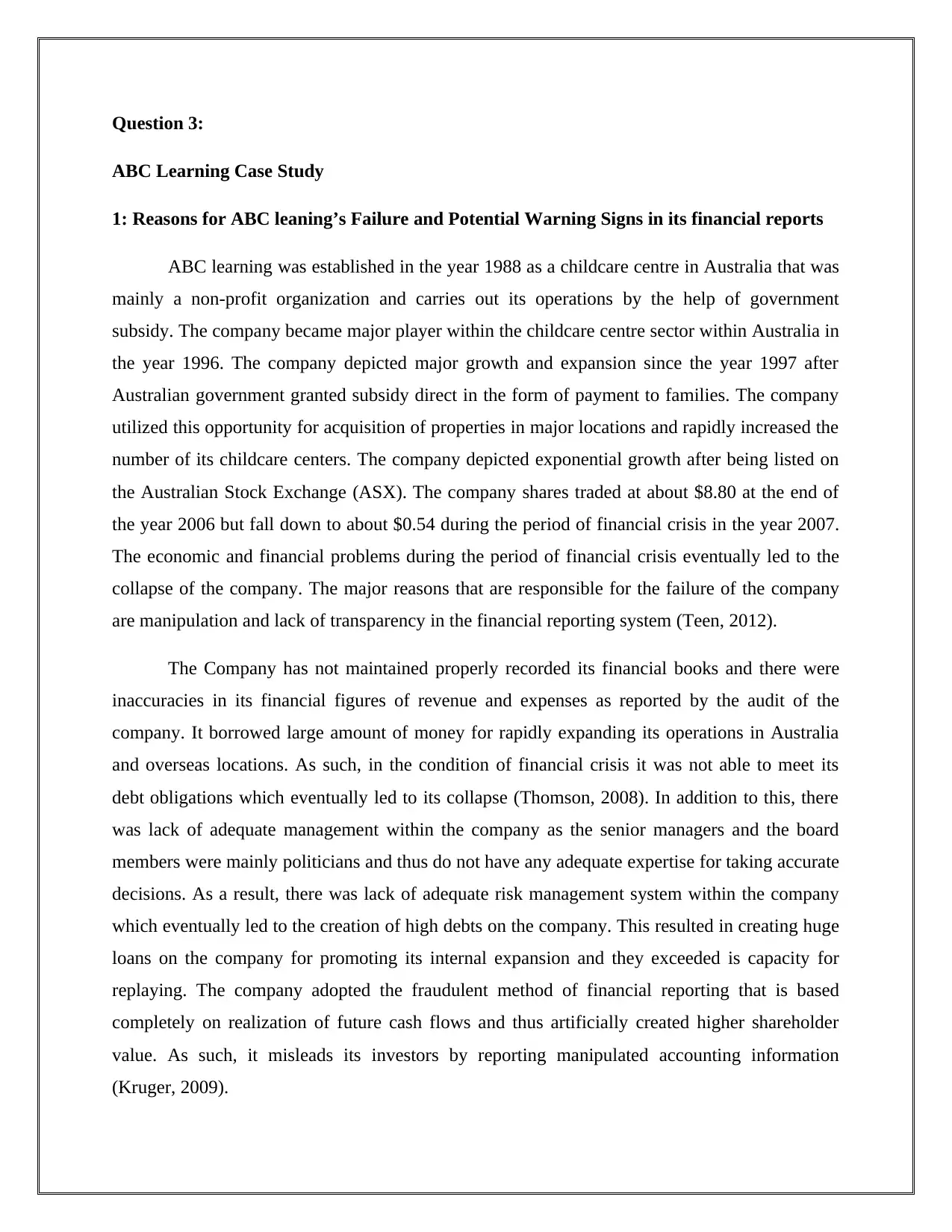
Question 3:
ABC Learning Case Study
1: Reasons for ABC leaning’s Failure and Potential Warning Signs in its financial reports
ABC learning was established in the year 1988 as a childcare centre in Australia that was
mainly a non-profit organization and carries out its operations by the help of government
subsidy. The company became major player within the childcare centre sector within Australia in
the year 1996. The company depicted major growth and expansion since the year 1997 after
Australian government granted subsidy direct in the form of payment to families. The company
utilized this opportunity for acquisition of properties in major locations and rapidly increased the
number of its childcare centers. The company depicted exponential growth after being listed on
the Australian Stock Exchange (ASX). The company shares traded at about $8.80 at the end of
the year 2006 but fall down to about $0.54 during the period of financial crisis in the year 2007.
The economic and financial problems during the period of financial crisis eventually led to the
collapse of the company. The major reasons that are responsible for the failure of the company
are manipulation and lack of transparency in the financial reporting system (Teen, 2012).
The Company has not maintained properly recorded its financial books and there were
inaccuracies in its financial figures of revenue and expenses as reported by the audit of the
company. It borrowed large amount of money for rapidly expanding its operations in Australia
and overseas locations. As such, in the condition of financial crisis it was not able to meet its
debt obligations which eventually led to its collapse (Thomson, 2008). In addition to this, there
was lack of adequate management within the company as the senior managers and the board
members were mainly politicians and thus do not have any adequate expertise for taking accurate
decisions. As a result, there was lack of adequate risk management system within the company
which eventually led to the creation of high debts on the company. This resulted in creating huge
loans on the company for promoting its internal expansion and they exceeded is capacity for
replaying. The company adopted the fraudulent method of financial reporting that is based
completely on realization of future cash flows and thus artificially created higher shareholder
value. As such, it misleads its investors by reporting manipulated accounting information
(Kruger, 2009).
ABC Learning Case Study
1: Reasons for ABC leaning’s Failure and Potential Warning Signs in its financial reports
ABC learning was established in the year 1988 as a childcare centre in Australia that was
mainly a non-profit organization and carries out its operations by the help of government
subsidy. The company became major player within the childcare centre sector within Australia in
the year 1996. The company depicted major growth and expansion since the year 1997 after
Australian government granted subsidy direct in the form of payment to families. The company
utilized this opportunity for acquisition of properties in major locations and rapidly increased the
number of its childcare centers. The company depicted exponential growth after being listed on
the Australian Stock Exchange (ASX). The company shares traded at about $8.80 at the end of
the year 2006 but fall down to about $0.54 during the period of financial crisis in the year 2007.
The economic and financial problems during the period of financial crisis eventually led to the
collapse of the company. The major reasons that are responsible for the failure of the company
are manipulation and lack of transparency in the financial reporting system (Teen, 2012).
The Company has not maintained properly recorded its financial books and there were
inaccuracies in its financial figures of revenue and expenses as reported by the audit of the
company. It borrowed large amount of money for rapidly expanding its operations in Australia
and overseas locations. As such, in the condition of financial crisis it was not able to meet its
debt obligations which eventually led to its collapse (Thomson, 2008). In addition to this, there
was lack of adequate management within the company as the senior managers and the board
members were mainly politicians and thus do not have any adequate expertise for taking accurate
decisions. As a result, there was lack of adequate risk management system within the company
which eventually led to the creation of high debts on the company. This resulted in creating huge
loans on the company for promoting its internal expansion and they exceeded is capacity for
replaying. The company adopted the fraudulent method of financial reporting that is based
completely on realization of future cash flows and thus artificially created higher shareholder
value. As such, it misleads its investors by reporting manipulated accounting information
(Kruger, 2009).
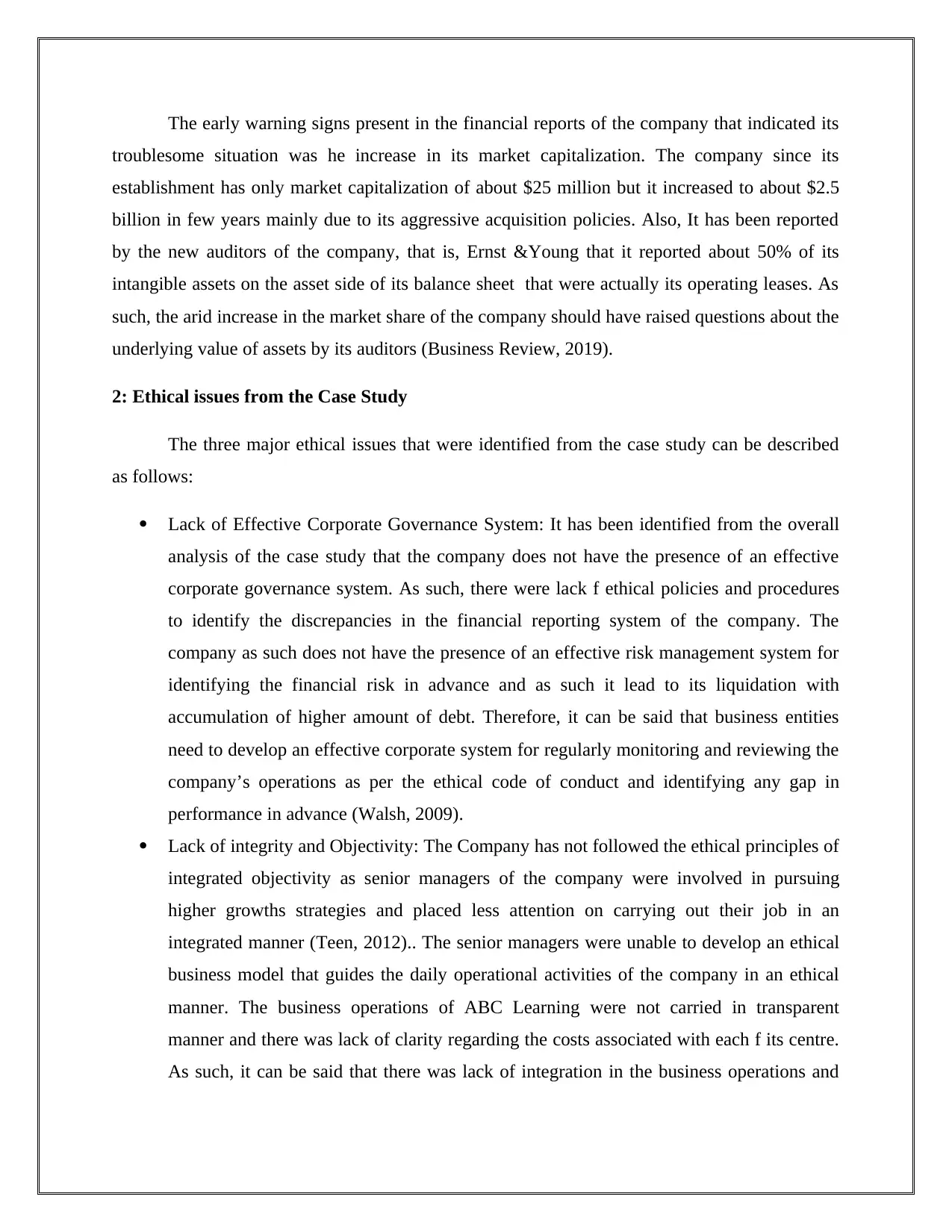
The early warning signs present in the financial reports of the company that indicated its
troublesome situation was he increase in its market capitalization. The company since its
establishment has only market capitalization of about $25 million but it increased to about $2.5
billion in few years mainly due to its aggressive acquisition policies. Also, It has been reported
by the new auditors of the company, that is, Ernst &Young that it reported about 50% of its
intangible assets on the asset side of its balance sheet that were actually its operating leases. As
such, the arid increase in the market share of the company should have raised questions about the
underlying value of assets by its auditors (Business Review, 2019).
2: Ethical issues from the Case Study
The three major ethical issues that were identified from the case study can be described
as follows:
Lack of Effective Corporate Governance System: It has been identified from the overall
analysis of the case study that the company does not have the presence of an effective
corporate governance system. As such, there were lack f ethical policies and procedures
to identify the discrepancies in the financial reporting system of the company. The
company as such does not have the presence of an effective risk management system for
identifying the financial risk in advance and as such it lead to its liquidation with
accumulation of higher amount of debt. Therefore, it can be said that business entities
need to develop an effective corporate system for regularly monitoring and reviewing the
company’s operations as per the ethical code of conduct and identifying any gap in
performance in advance (Walsh, 2009).
Lack of integrity and Objectivity: The Company has not followed the ethical principles of
integrated objectivity as senior managers of the company were involved in pursuing
higher growths strategies and placed less attention on carrying out their job in an
integrated manner (Teen, 2012).. The senior managers were unable to develop an ethical
business model that guides the daily operational activities of the company in an ethical
manner. The business operations of ABC Learning were not carried in transparent
manner and there was lack of clarity regarding the costs associated with each f its centre.
As such, it can be said that there was lack of integration in the business operations and
troublesome situation was he increase in its market capitalization. The company since its
establishment has only market capitalization of about $25 million but it increased to about $2.5
billion in few years mainly due to its aggressive acquisition policies. Also, It has been reported
by the new auditors of the company, that is, Ernst &Young that it reported about 50% of its
intangible assets on the asset side of its balance sheet that were actually its operating leases. As
such, the arid increase in the market share of the company should have raised questions about the
underlying value of assets by its auditors (Business Review, 2019).
2: Ethical issues from the Case Study
The three major ethical issues that were identified from the case study can be described
as follows:
Lack of Effective Corporate Governance System: It has been identified from the overall
analysis of the case study that the company does not have the presence of an effective
corporate governance system. As such, there were lack f ethical policies and procedures
to identify the discrepancies in the financial reporting system of the company. The
company as such does not have the presence of an effective risk management system for
identifying the financial risk in advance and as such it lead to its liquidation with
accumulation of higher amount of debt. Therefore, it can be said that business entities
need to develop an effective corporate system for regularly monitoring and reviewing the
company’s operations as per the ethical code of conduct and identifying any gap in
performance in advance (Walsh, 2009).
Lack of integrity and Objectivity: The Company has not followed the ethical principles of
integrated objectivity as senior managers of the company were involved in pursuing
higher growths strategies and placed less attention on carrying out their job in an
integrated manner (Teen, 2012).. The senior managers were unable to develop an ethical
business model that guides the daily operational activities of the company in an ethical
manner. The business operations of ABC Learning were not carried in transparent
manner and there was lack of clarity regarding the costs associated with each f its centre.
As such, it can be said that there was lack of integration in the business operations and
Paraphrase This Document
Need a fresh take? Get an instant paraphrase of this document with our AI Paraphraser

there were determined only for achieving higher growth objectives and ignored the
welfare of its various stakeholders (Thomson, 2008).
Professional Competence and Due Care: The inflation of earnings by the use of
fraudulent accounting practices has reflected that accountants have not acted with utmost
care and professional competence in preparation of the financial statements. Also, the
discrepancies in the financial reporting system were unidentified by the auditor of the
company which reflected lack of independence on their part. The auditors of the company
has not carried out their work responsibilities effectively which lead to un-identification
of such fraudulent accounting practices within the company. The auditors have not
complied with the standard auditing policies that regulate the working of their profession.
They have acted against the interest of the third parties such as investors and creditors f
the company. As such, it can be said from the analysis of the case study of the company
that auditors need to carry out their work in an ethical manner for protecting the interest
of the end-users. They should abide by the ethical policies and procedures during
reviewing the financial information of a company and should report any discrepancies
found in advance (Arens, 2013).
welfare of its various stakeholders (Thomson, 2008).
Professional Competence and Due Care: The inflation of earnings by the use of
fraudulent accounting practices has reflected that accountants have not acted with utmost
care and professional competence in preparation of the financial statements. Also, the
discrepancies in the financial reporting system were unidentified by the auditor of the
company which reflected lack of independence on their part. The auditors of the company
has not carried out their work responsibilities effectively which lead to un-identification
of such fraudulent accounting practices within the company. The auditors have not
complied with the standard auditing policies that regulate the working of their profession.
They have acted against the interest of the third parties such as investors and creditors f
the company. As such, it can be said from the analysis of the case study of the company
that auditors need to carry out their work in an ethical manner for protecting the interest
of the end-users. They should abide by the ethical policies and procedures during
reviewing the financial information of a company and should report any discrepancies
found in advance (Arens, 2013).

References
Andreica, I. (2016). Double-entry Bookkeeping versus Simple-entry Bookkeeping. Horticulture
73(2), 282-290.
Arens, A.A. (2013). Auditing, Assurance Services and Ethics in Australia. Queensland: P.Ed
Australia.
Brigham, F., & Michael C. (2013). Financial management: Theory & practice. Canada: Cengage
Learning.
Business Review. (2019). The ABC of policy failure. Retrieved 2 April, 2019, from
https://www.theaustralian.com.au/business/business-spectator/news-story/the-abc-of-
policy-failure/e5f9cb130150525aba97487de2a91c9d
Damodaran, A, (2011). Applied corporate finance. USA: John Wiley & sons.
Davies, T. & Crawford, I. (2011). Business accounting and finance. USA: Pearson.
Gleeson-White, J. (2011). Double Entry: How the merchants of Venice shaped the modern world
- and how their invention could make or break the planet. Sydney: Allen & Unwin.
Kruger, C. (2009). Lessons to be learnt from ABC Learning's collapse. Retrieved 2 April, 2019,
from https://www.smh.com.au/business/lessons-to-be-learnt-from-abc-learnings-collapse-
20090101-78f8.html
Teen, M. (2012). The ABC of a corporate collapse. Retrieved 2 April, 2019, from
https://governanceforstakeholders.com/2012/12/28/the-abc-of-a-corporate-collapse/
Thomson, J. (2008). Five lessons from the spectacular fall of Eddy Groves. Retrieved 2 April,
2019, from https://www.smartcompany.com.au/finance/five-lessons-from-the-
spectacular-fall-of-eddy-groves/
Walsh, L. (2009). Key corporate governance systems 'missing' from ABC. Retrieved 2 April,
2019, from https://www.couriermail.com.au/news/key-corporate-governance-systems-
Andreica, I. (2016). Double-entry Bookkeeping versus Simple-entry Bookkeeping. Horticulture
73(2), 282-290.
Arens, A.A. (2013). Auditing, Assurance Services and Ethics in Australia. Queensland: P.Ed
Australia.
Brigham, F., & Michael C. (2013). Financial management: Theory & practice. Canada: Cengage
Learning.
Business Review. (2019). The ABC of policy failure. Retrieved 2 April, 2019, from
https://www.theaustralian.com.au/business/business-spectator/news-story/the-abc-of-
policy-failure/e5f9cb130150525aba97487de2a91c9d
Damodaran, A, (2011). Applied corporate finance. USA: John Wiley & sons.
Davies, T. & Crawford, I. (2011). Business accounting and finance. USA: Pearson.
Gleeson-White, J. (2011). Double Entry: How the merchants of Venice shaped the modern world
- and how their invention could make or break the planet. Sydney: Allen & Unwin.
Kruger, C. (2009). Lessons to be learnt from ABC Learning's collapse. Retrieved 2 April, 2019,
from https://www.smh.com.au/business/lessons-to-be-learnt-from-abc-learnings-collapse-
20090101-78f8.html
Teen, M. (2012). The ABC of a corporate collapse. Retrieved 2 April, 2019, from
https://governanceforstakeholders.com/2012/12/28/the-abc-of-a-corporate-collapse/
Thomson, J. (2008). Five lessons from the spectacular fall of Eddy Groves. Retrieved 2 April,
2019, from https://www.smartcompany.com.au/finance/five-lessons-from-the-
spectacular-fall-of-eddy-groves/
Walsh, L. (2009). Key corporate governance systems 'missing' from ABC. Retrieved 2 April,
2019, from https://www.couriermail.com.au/news/key-corporate-governance-systems-
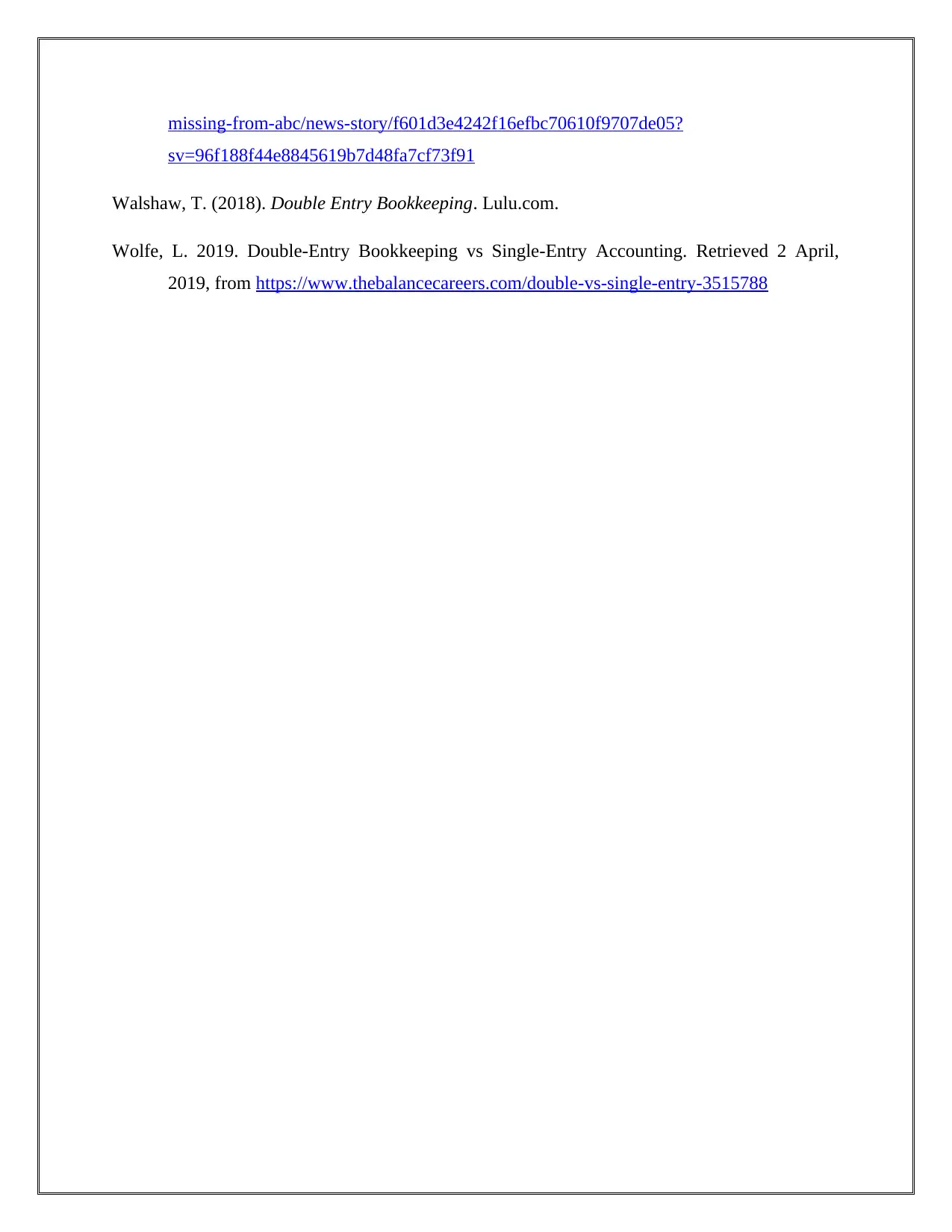
missing-from-abc/news-story/f601d3e4242f16efbc70610f9707de05?
sv=96f188f44e8845619b7d48fa7cf73f91
Walshaw, T. (2018). Double Entry Bookkeeping. Lulu.com.
Wolfe, L. 2019. Double-Entry Bookkeeping vs Single-Entry Accounting. Retrieved 2 April,
2019, from https://www.thebalancecareers.com/double-vs-single-entry-3515788
sv=96f188f44e8845619b7d48fa7cf73f91
Walshaw, T. (2018). Double Entry Bookkeeping. Lulu.com.
Wolfe, L. 2019. Double-Entry Bookkeeping vs Single-Entry Accounting. Retrieved 2 April,
2019, from https://www.thebalancecareers.com/double-vs-single-entry-3515788
1 out of 34
Related Documents
Your All-in-One AI-Powered Toolkit for Academic Success.
+13062052269
info@desklib.com
Available 24*7 on WhatsApp / Email
![[object Object]](/_next/static/media/star-bottom.7253800d.svg)
Unlock your academic potential
© 2024 | Zucol Services PVT LTD | All rights reserved.





